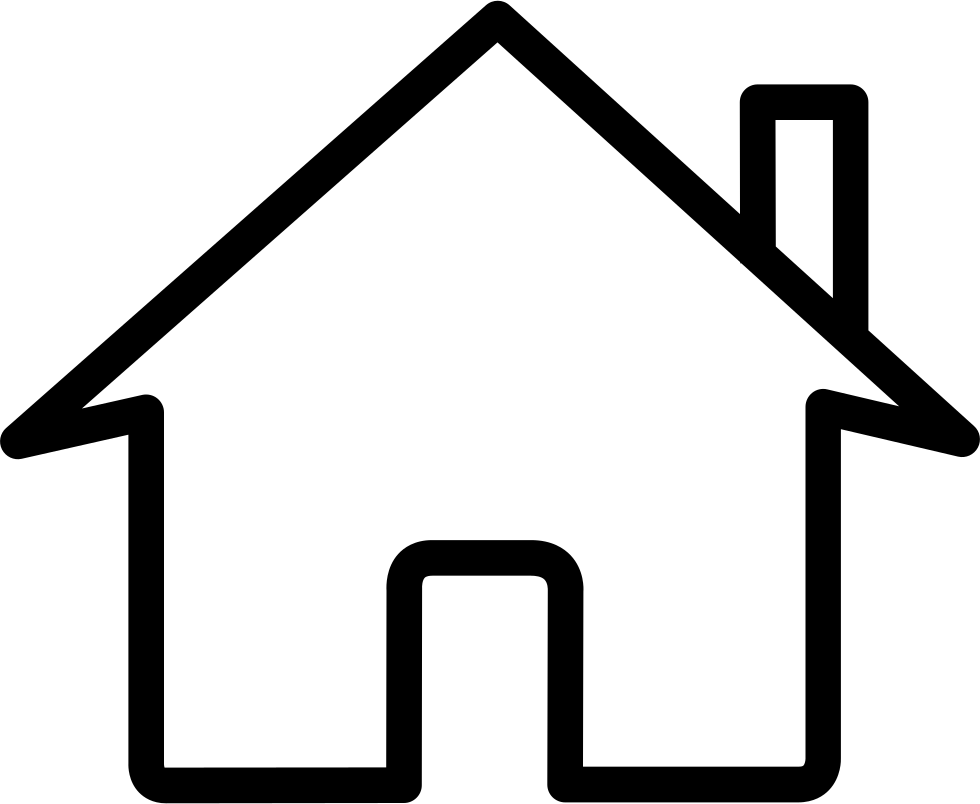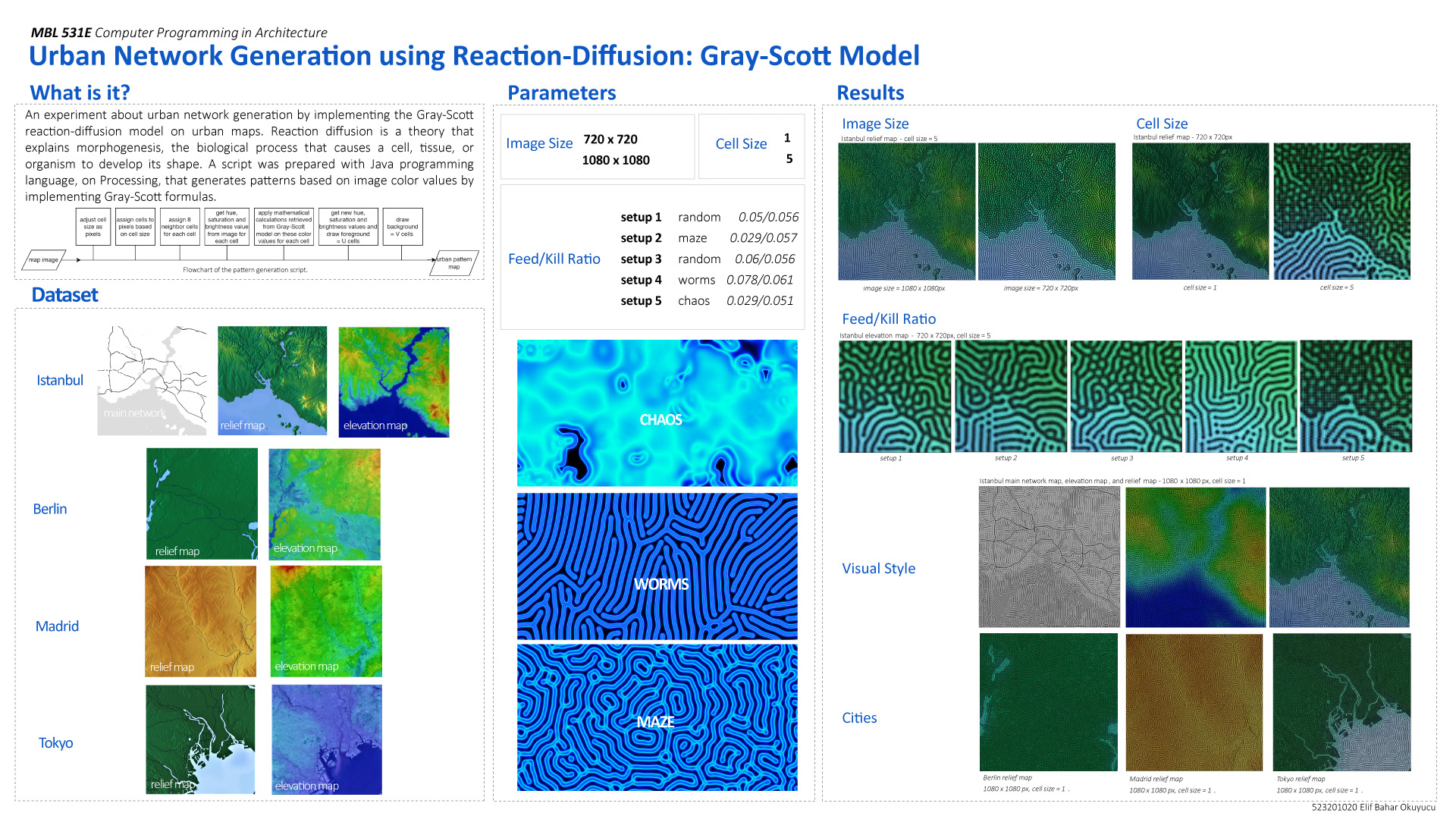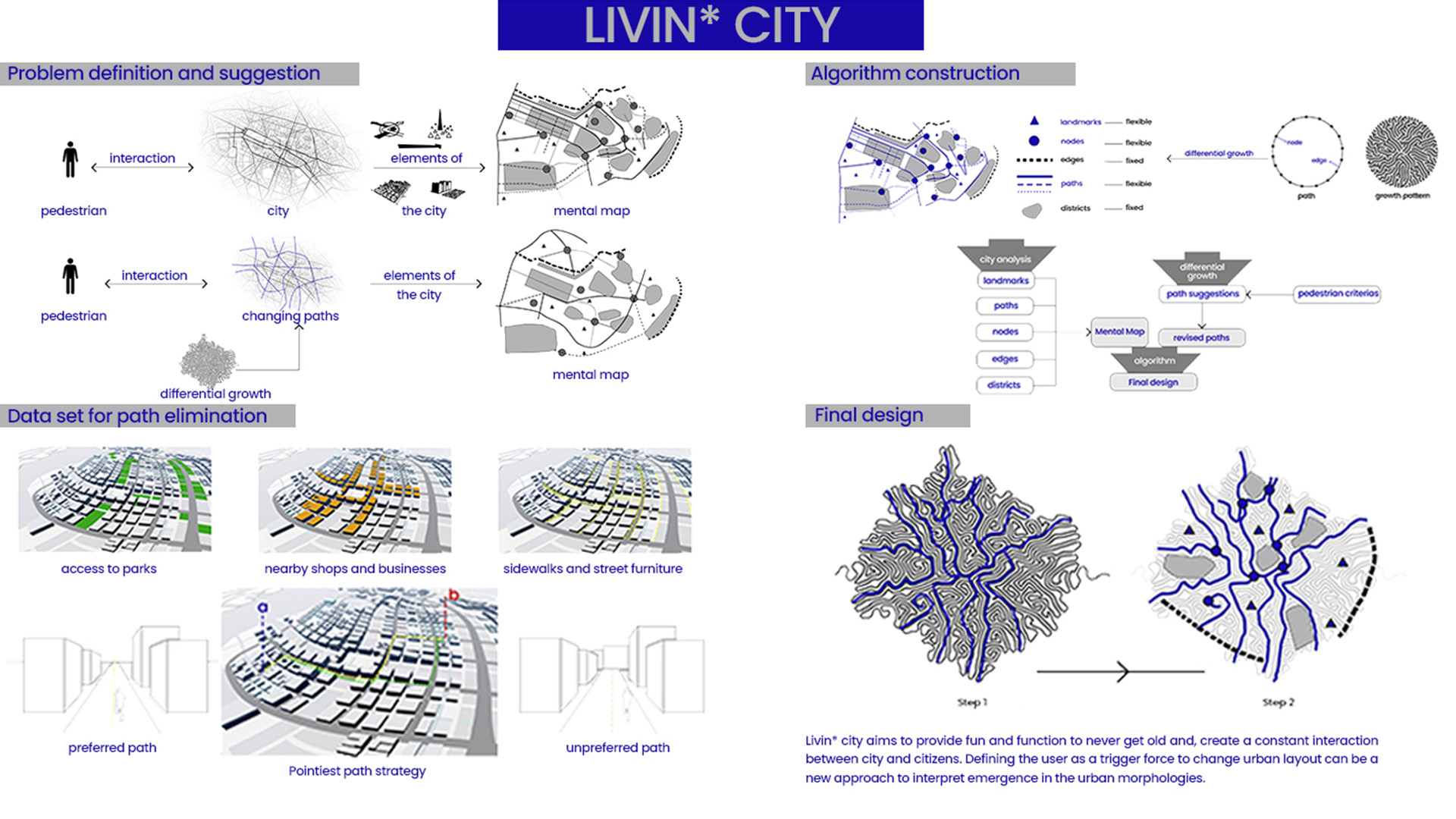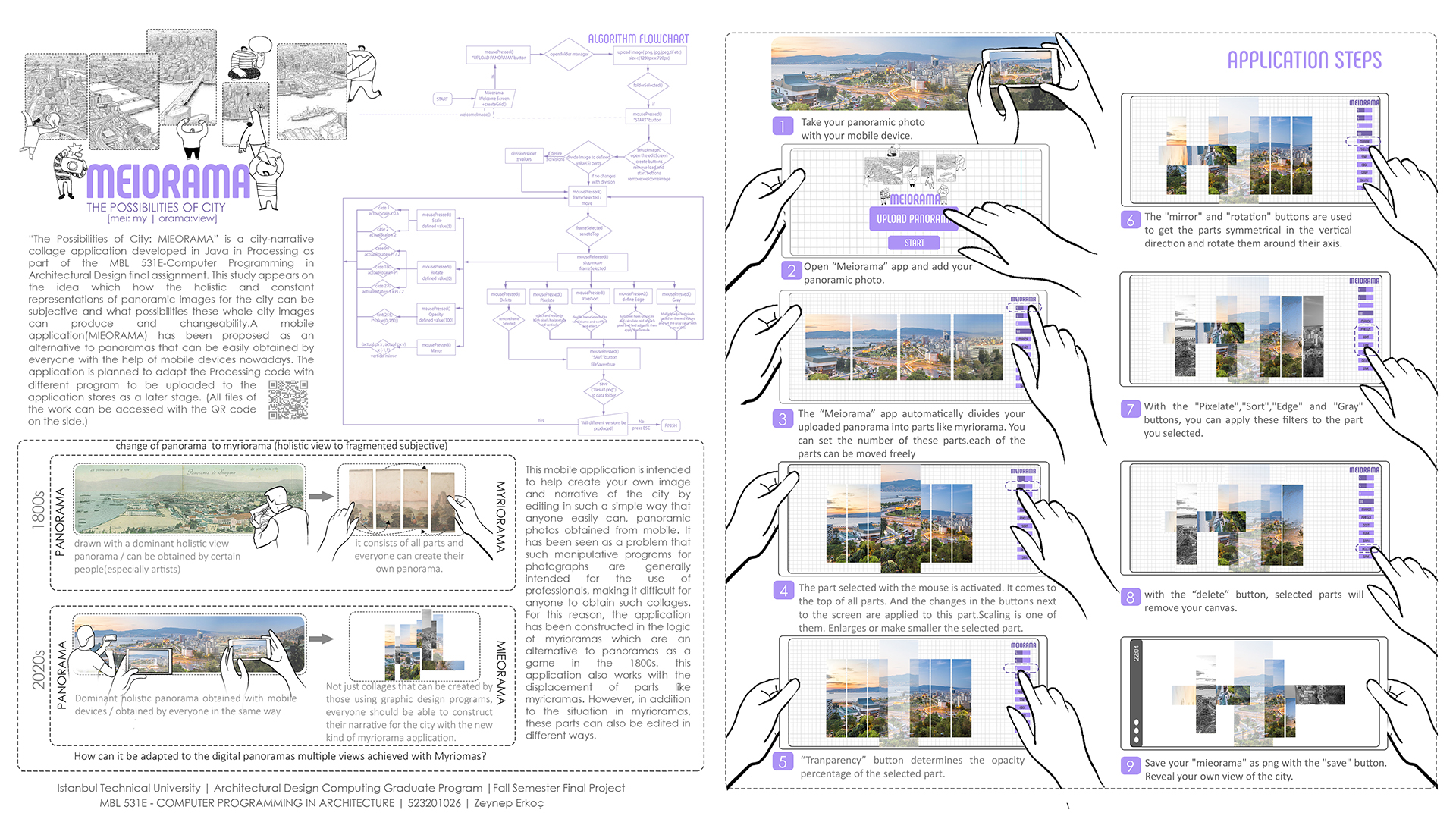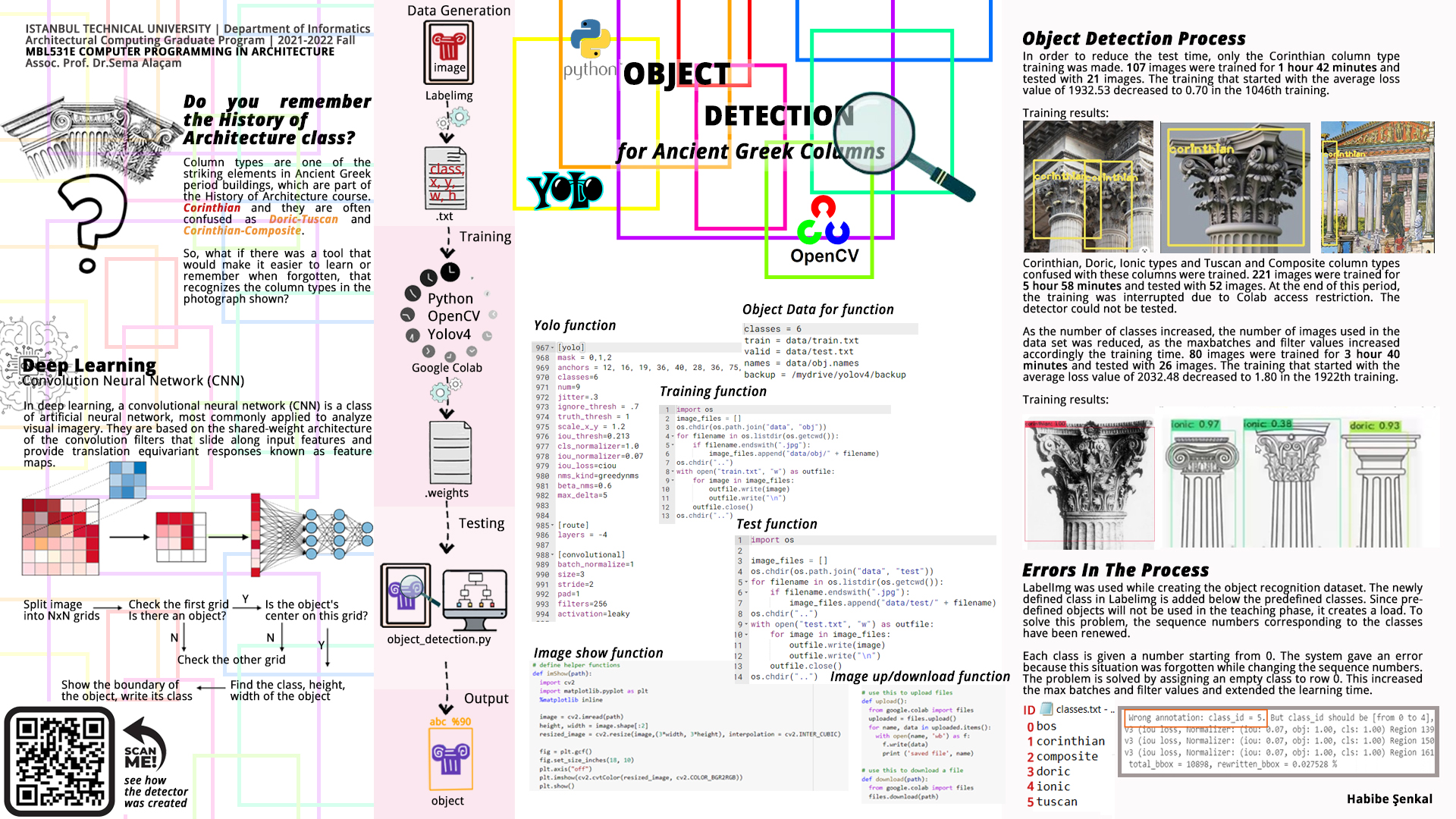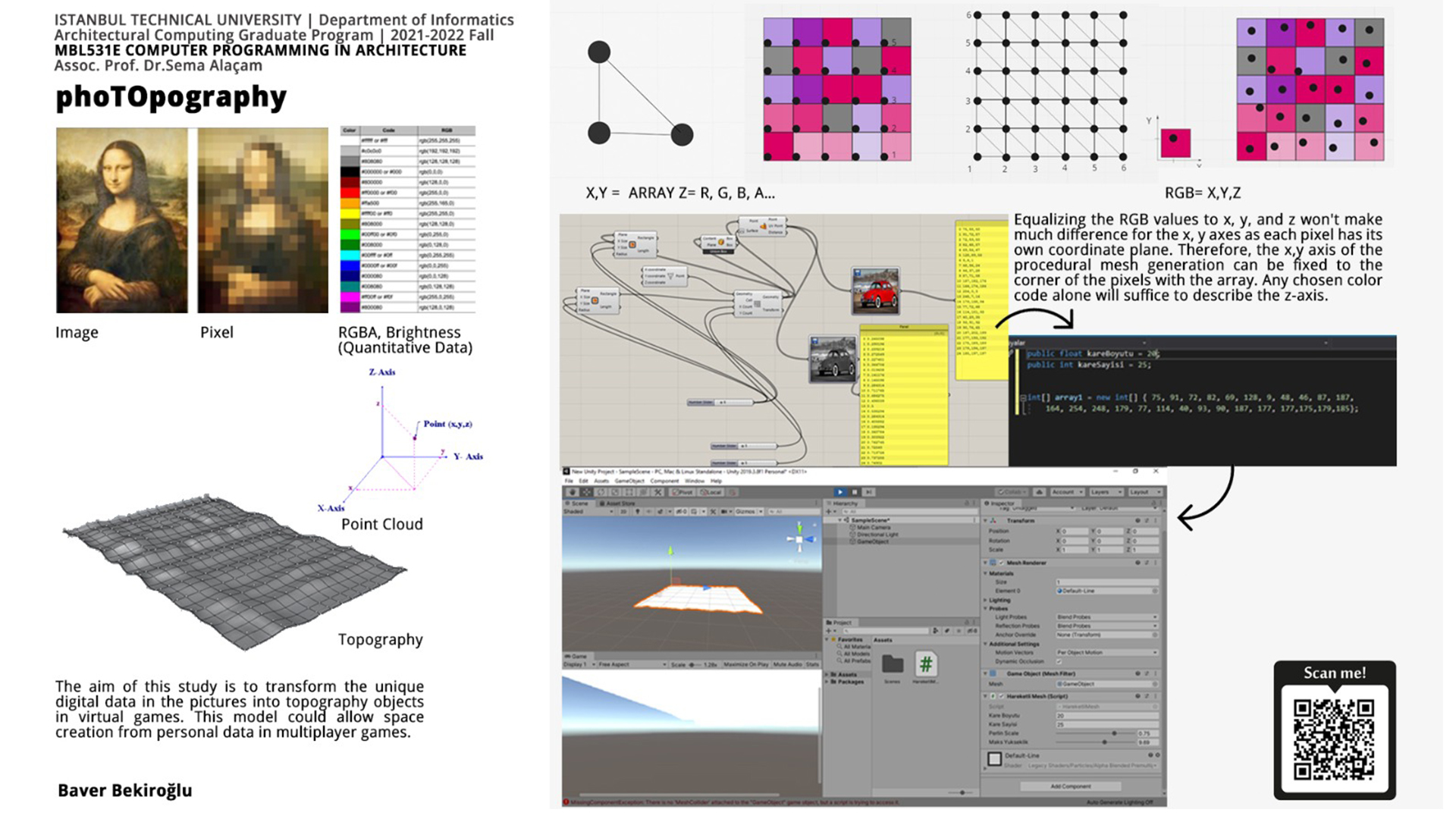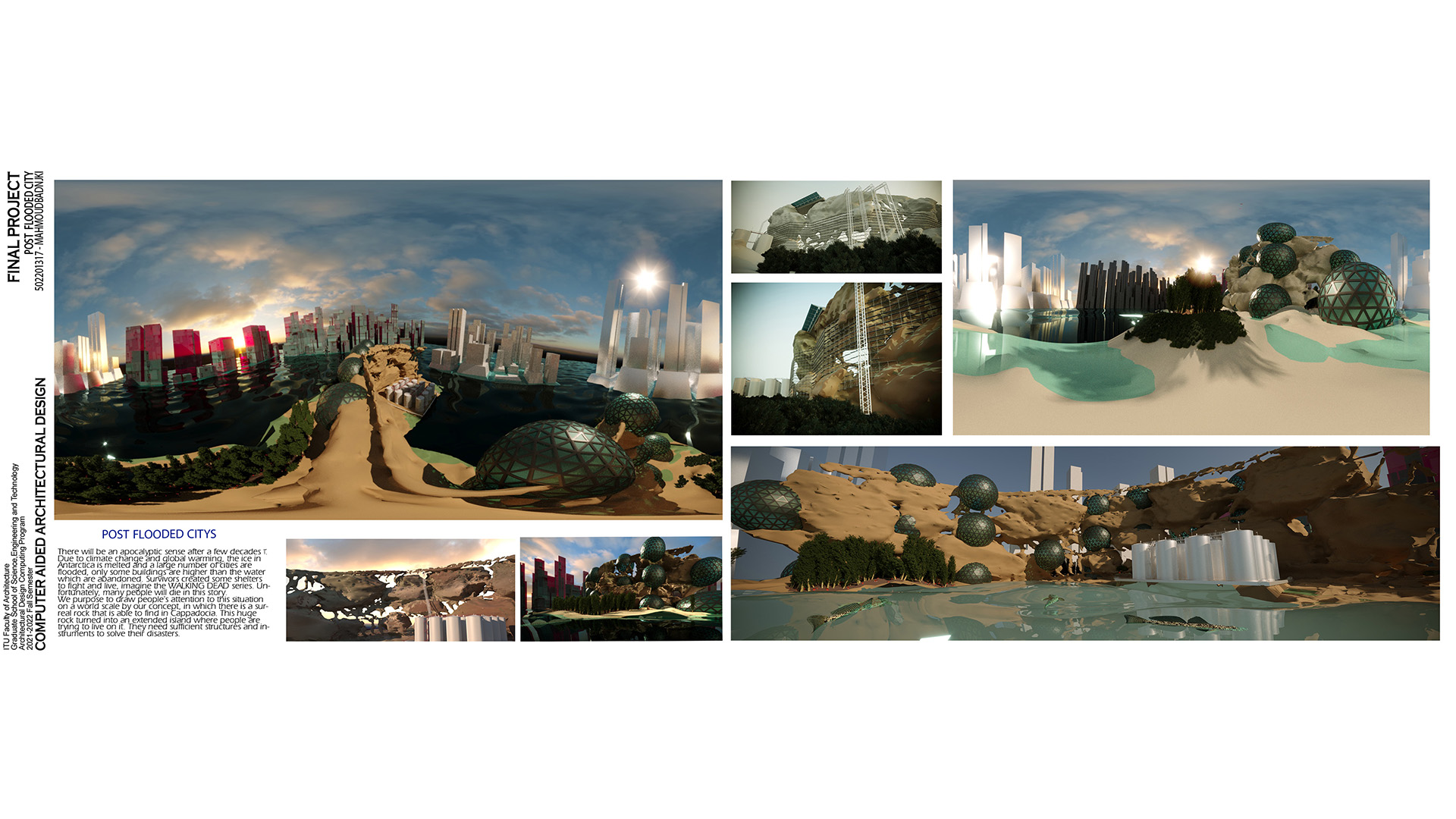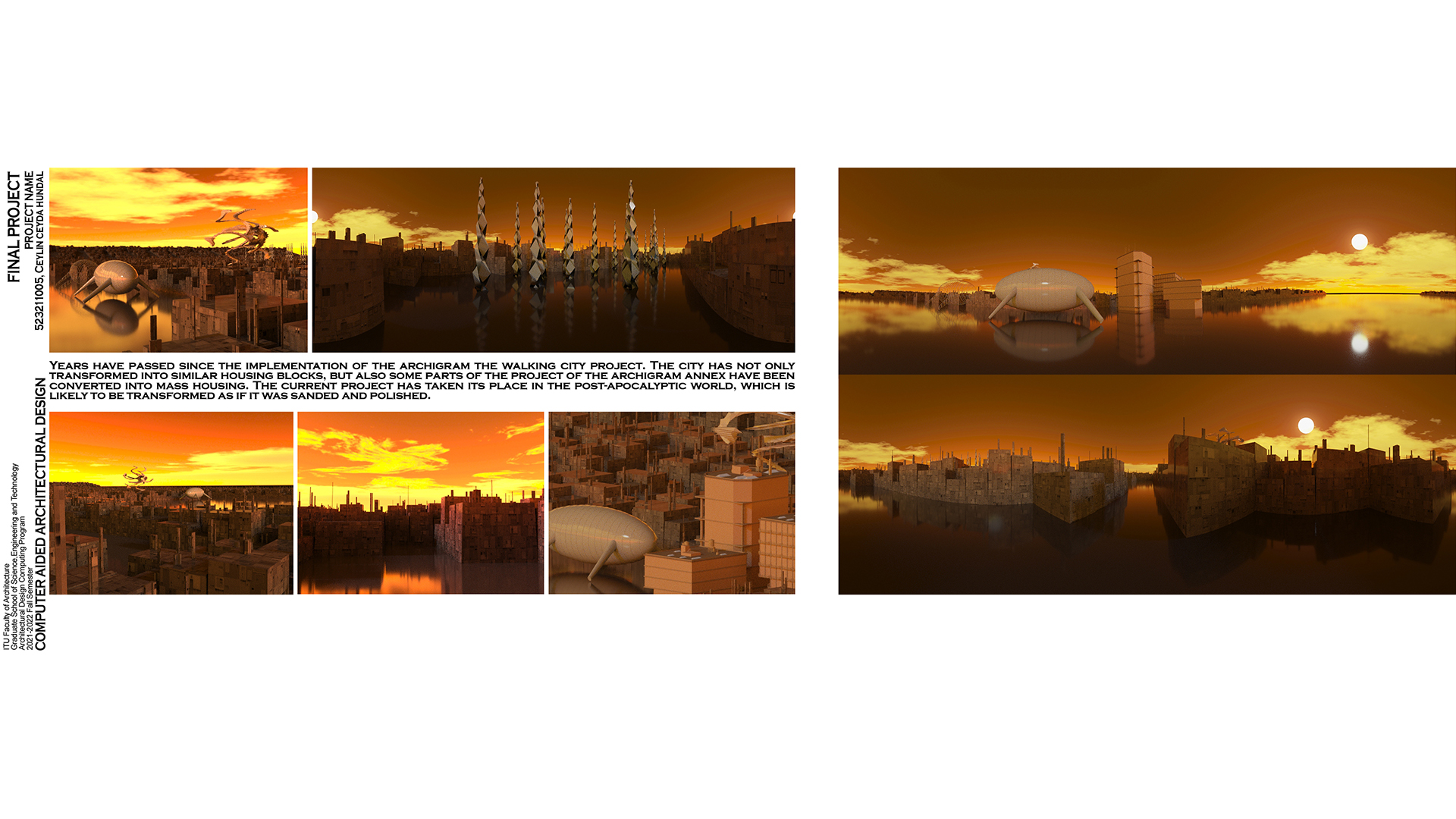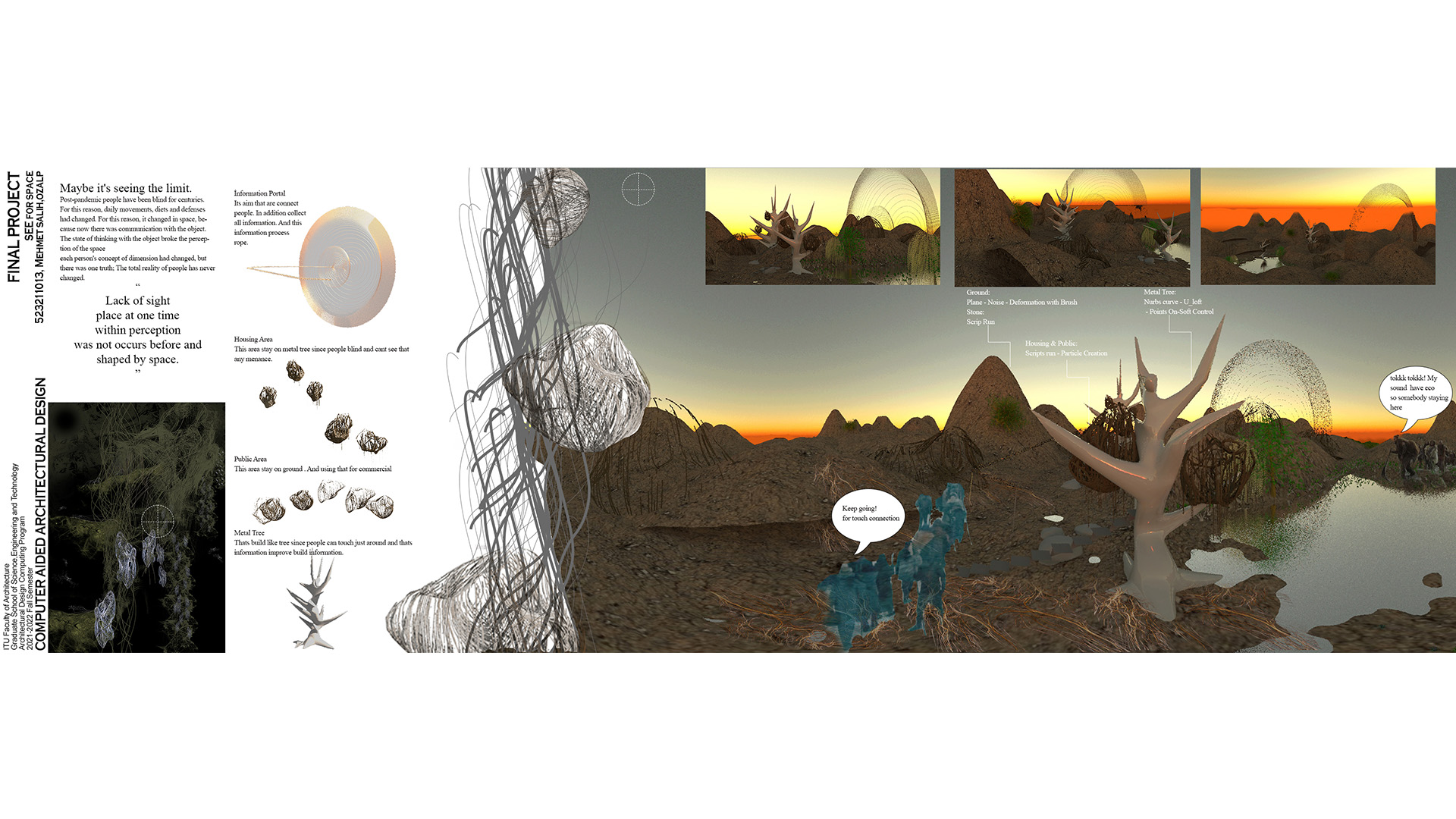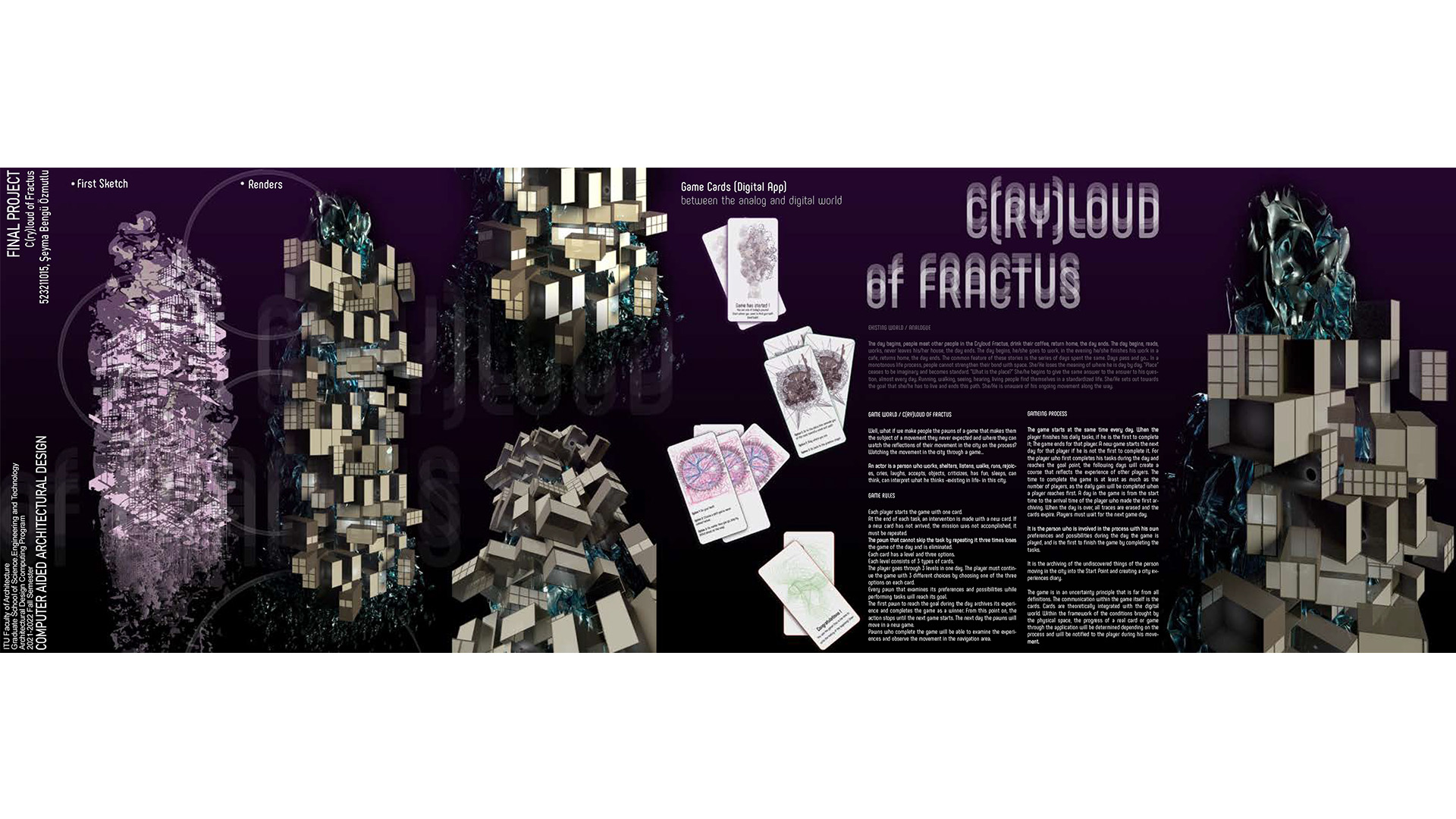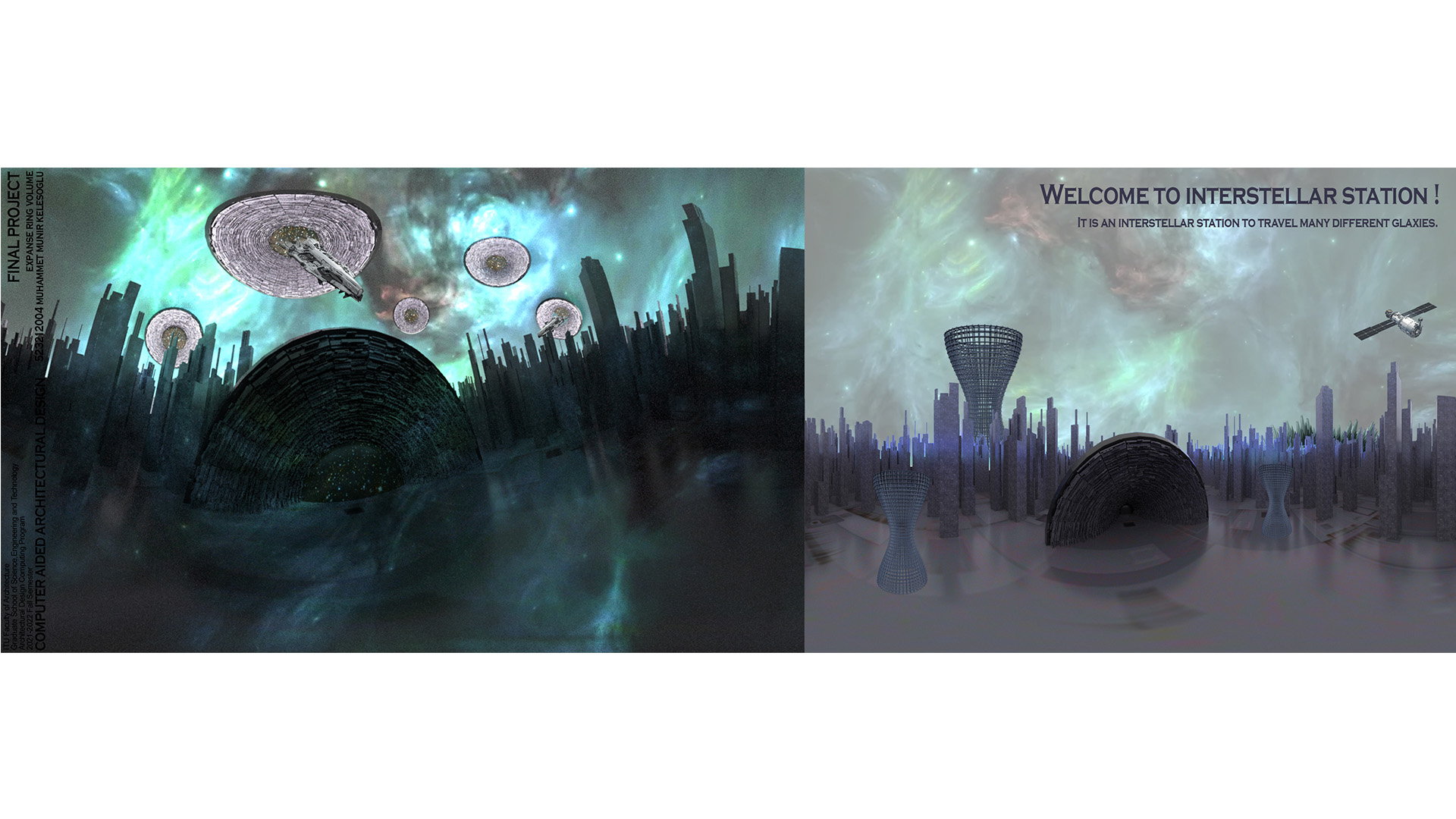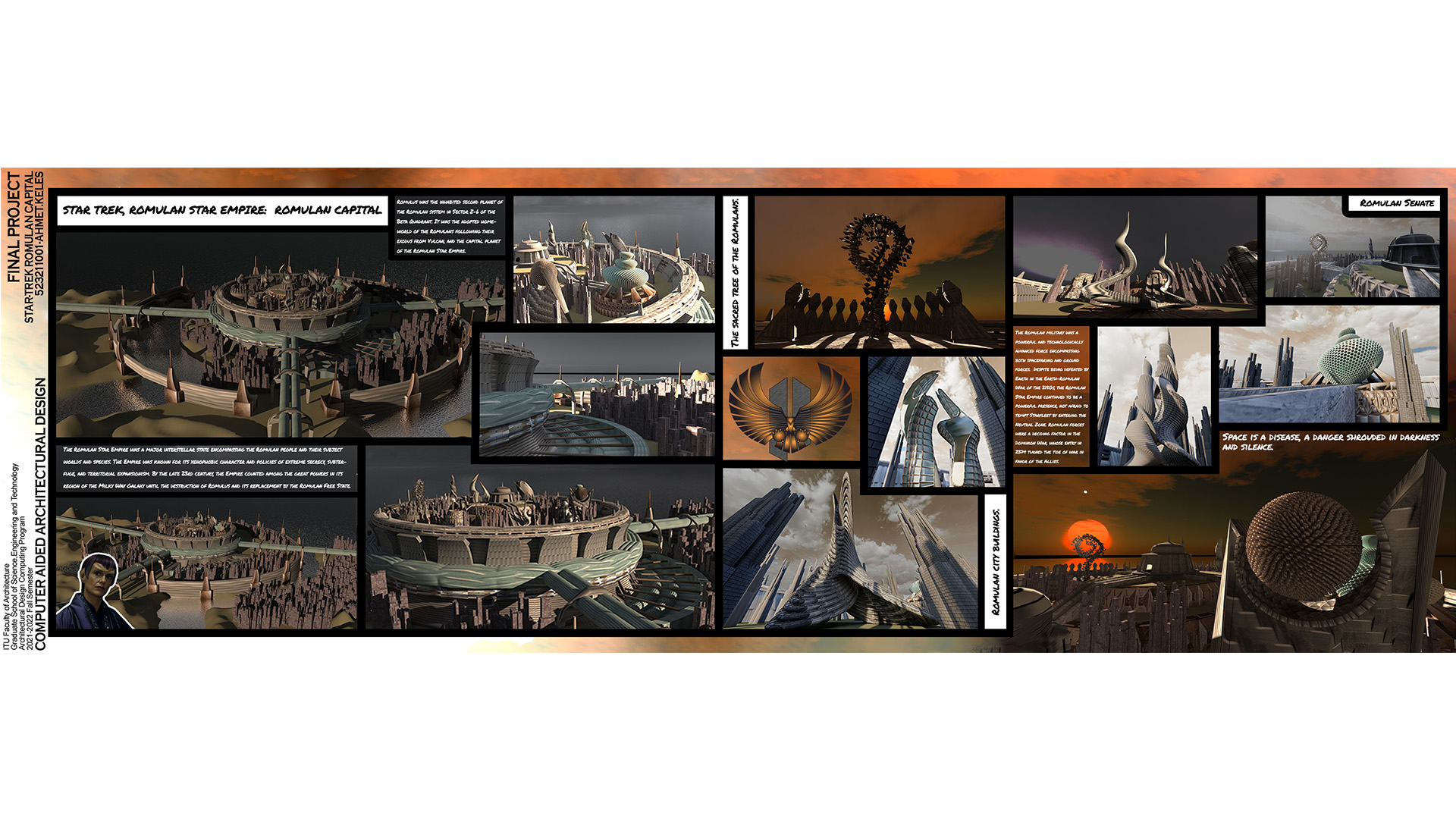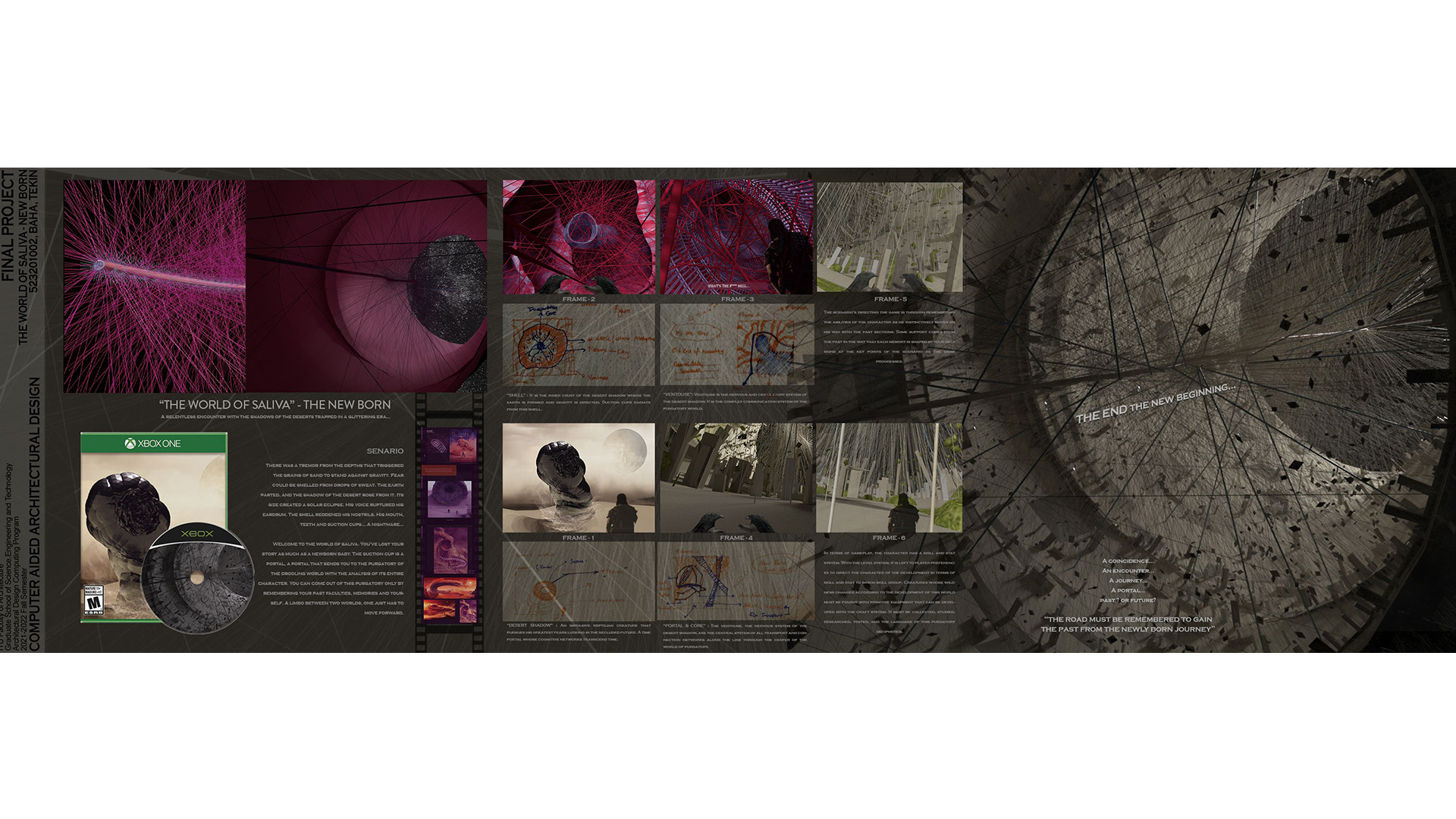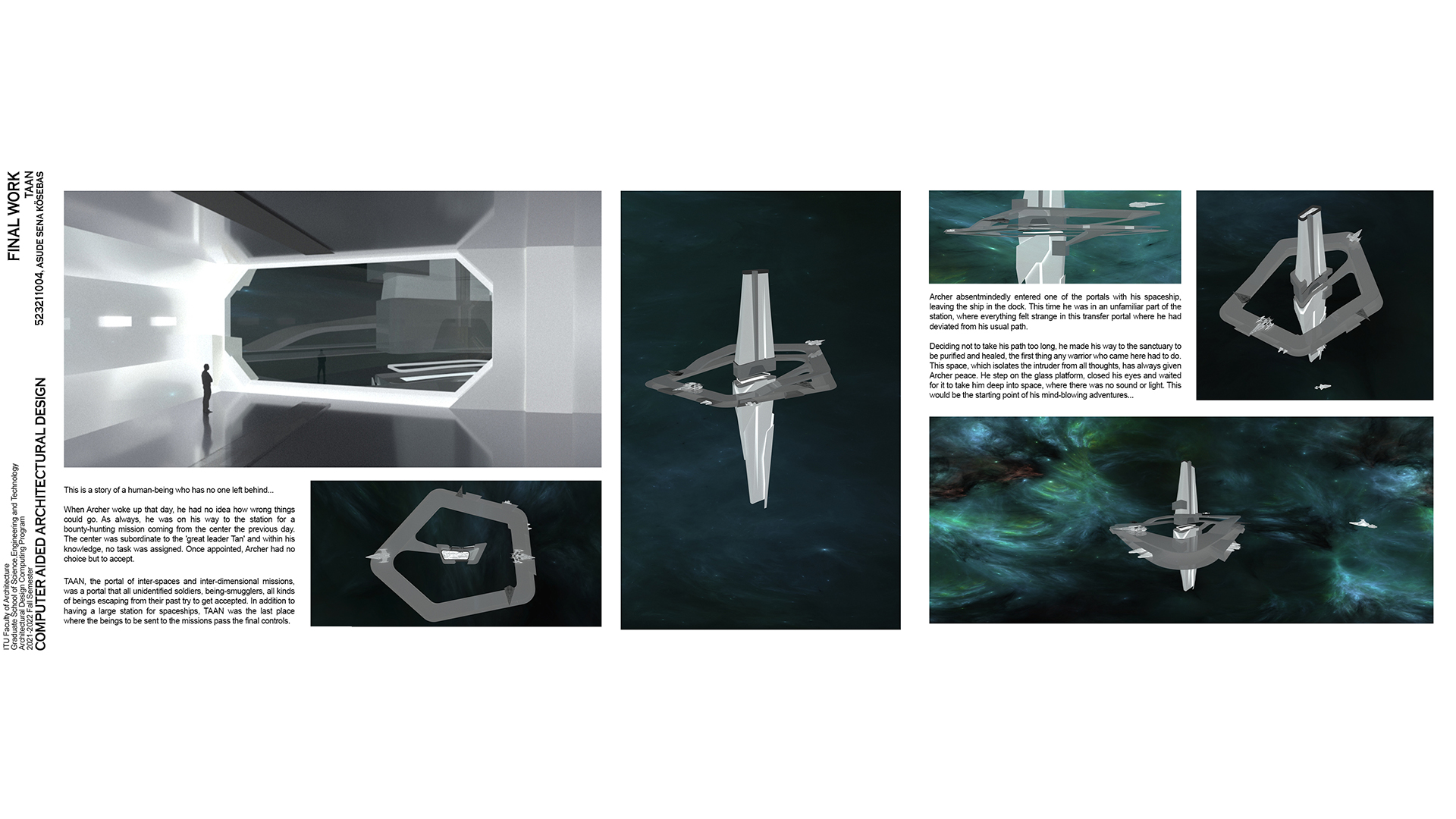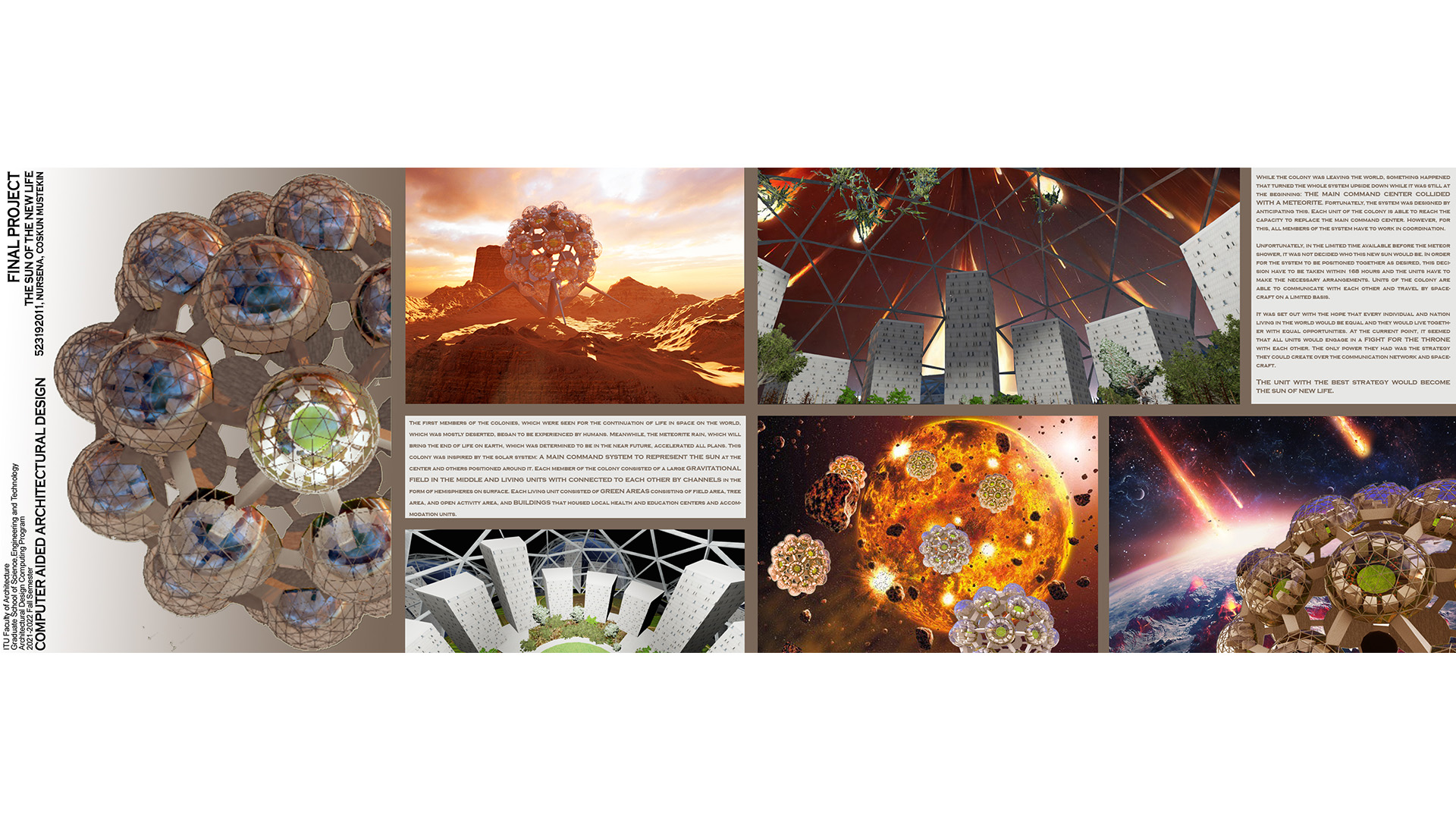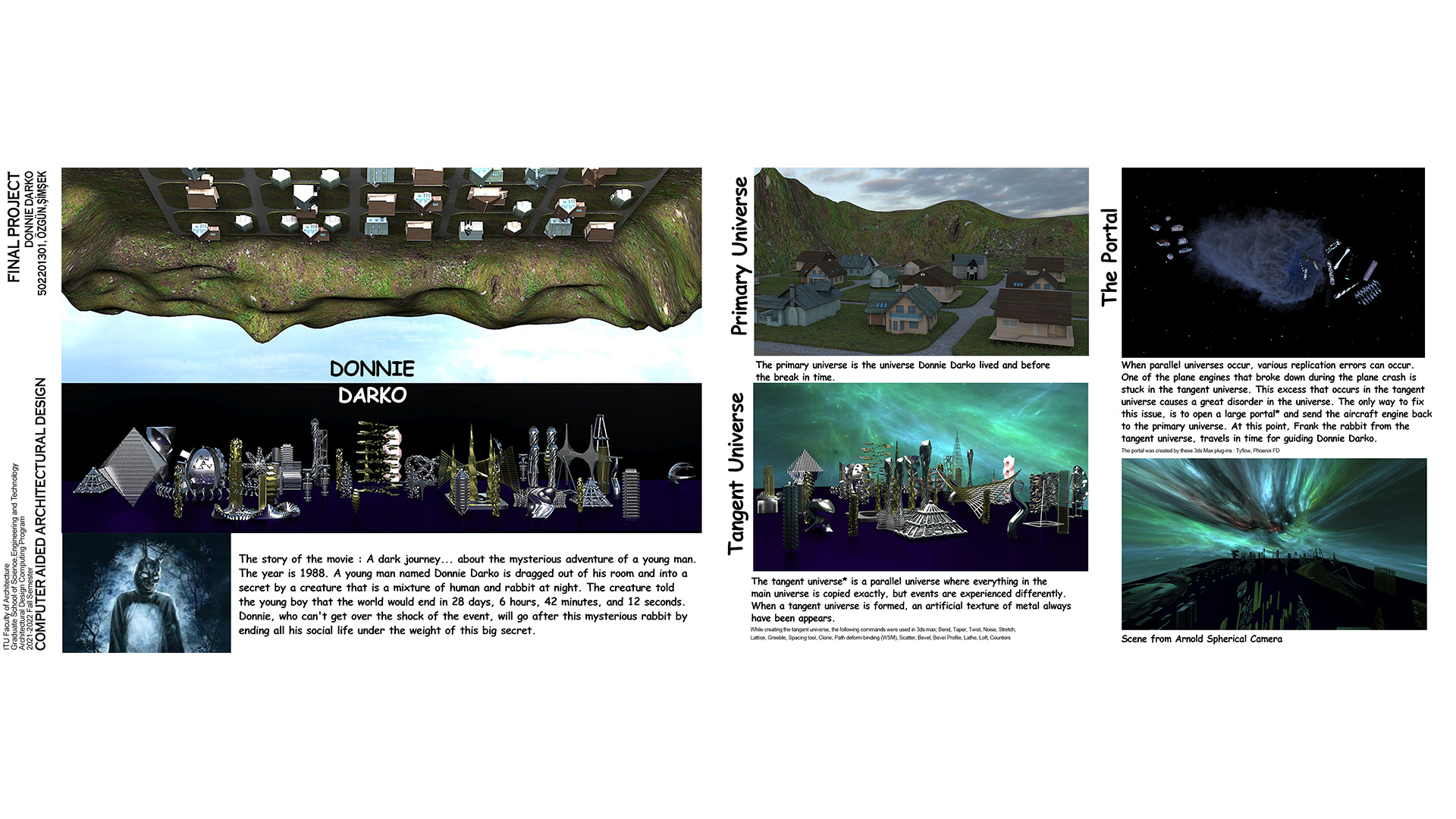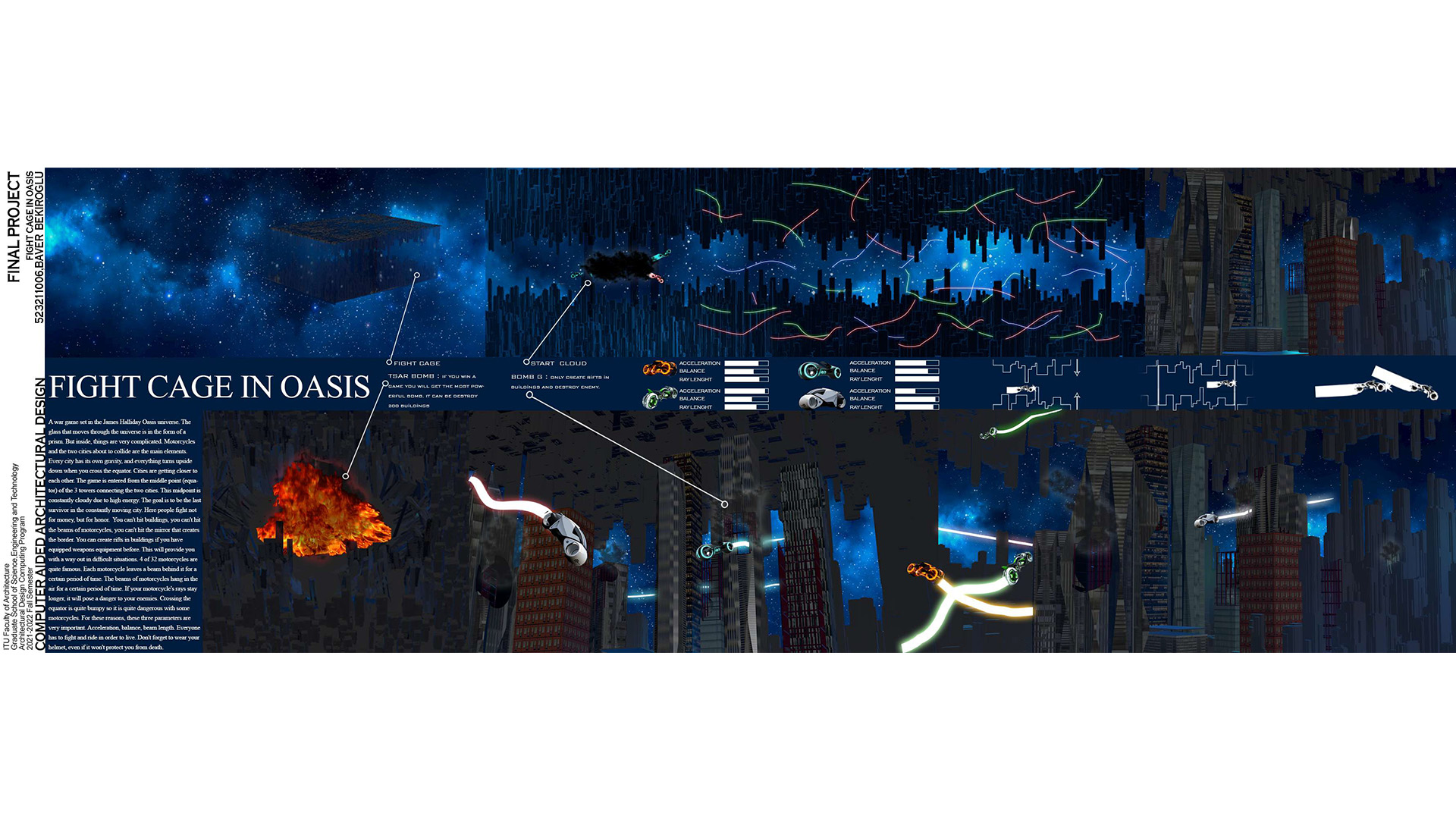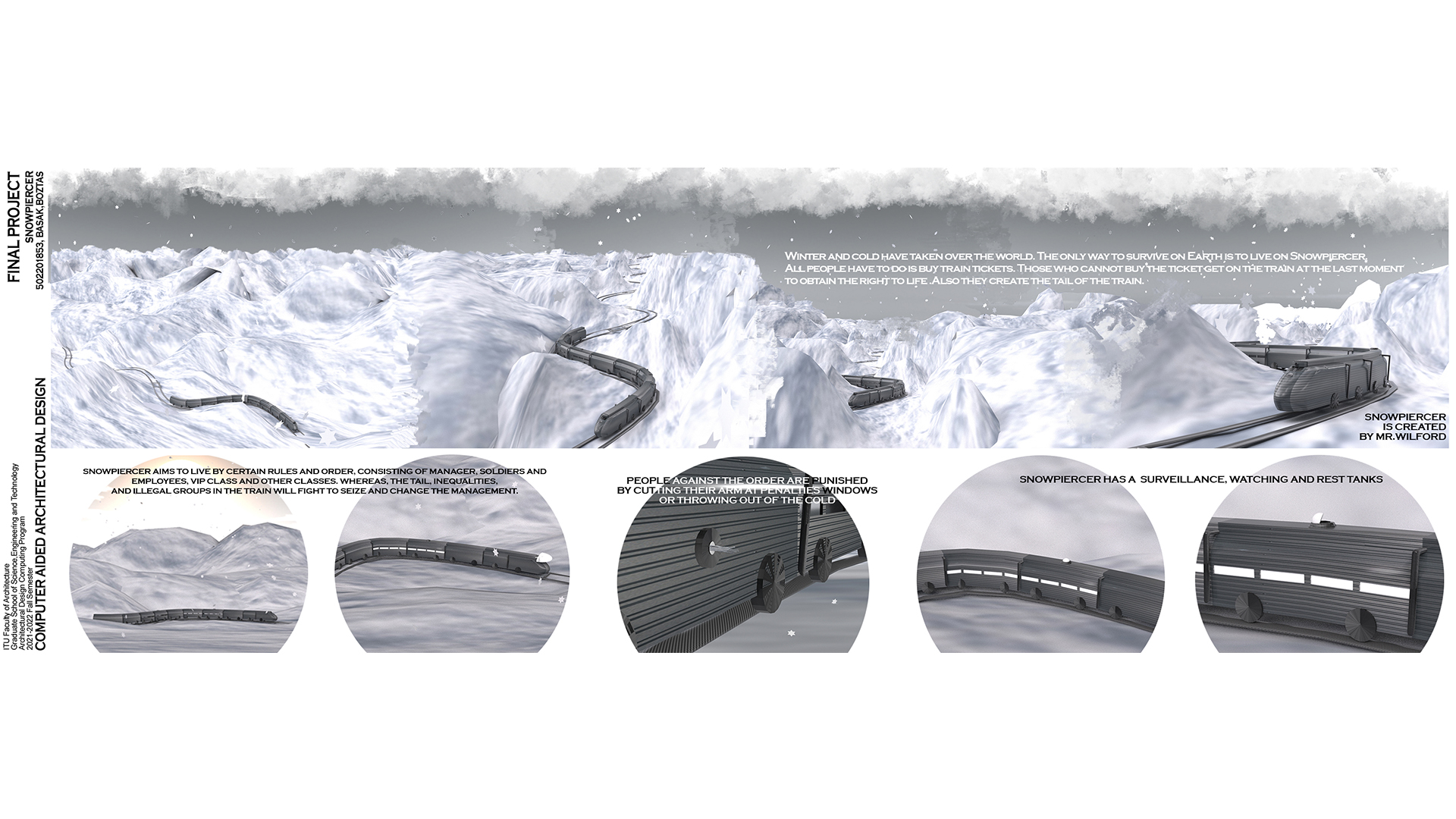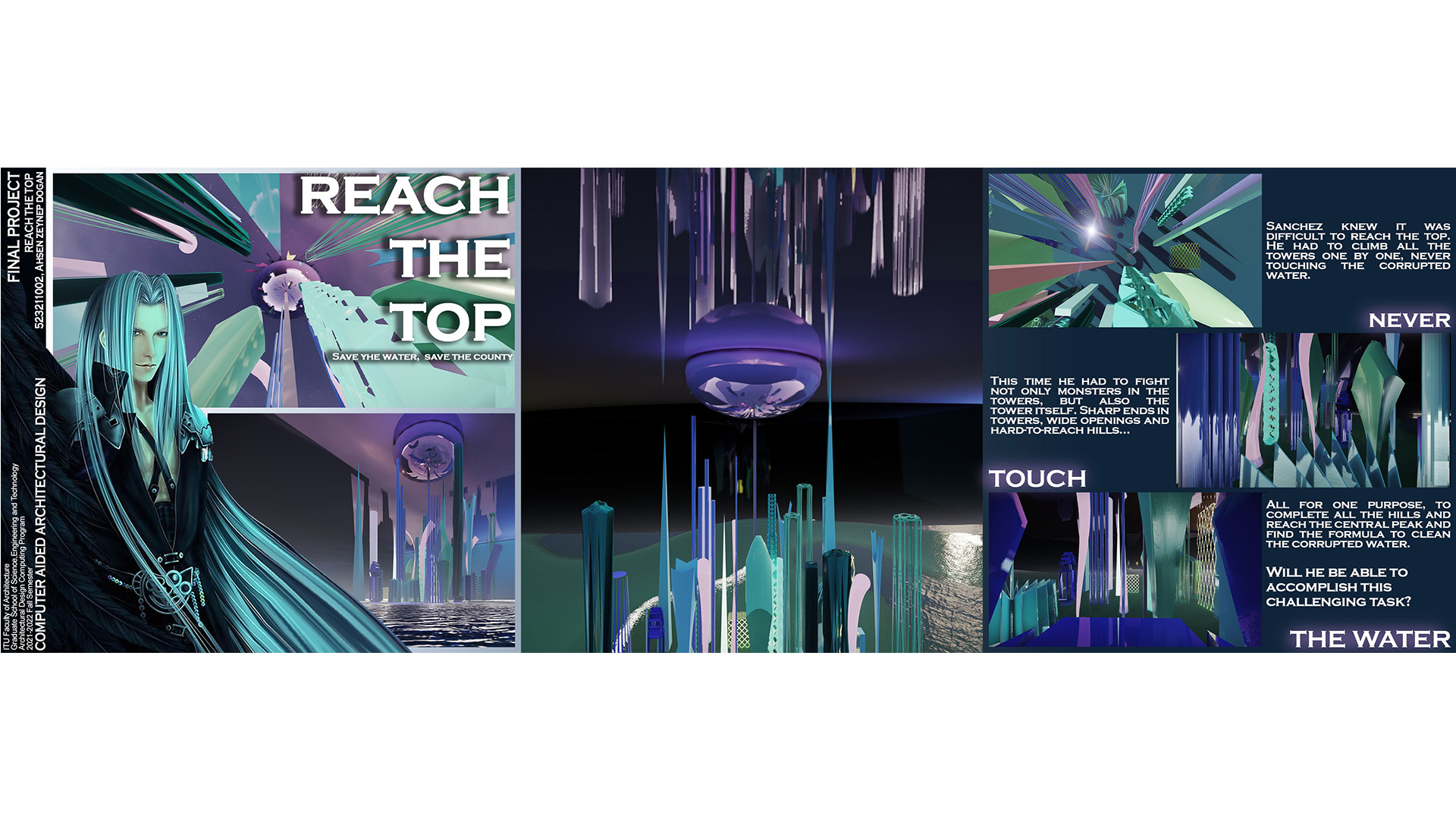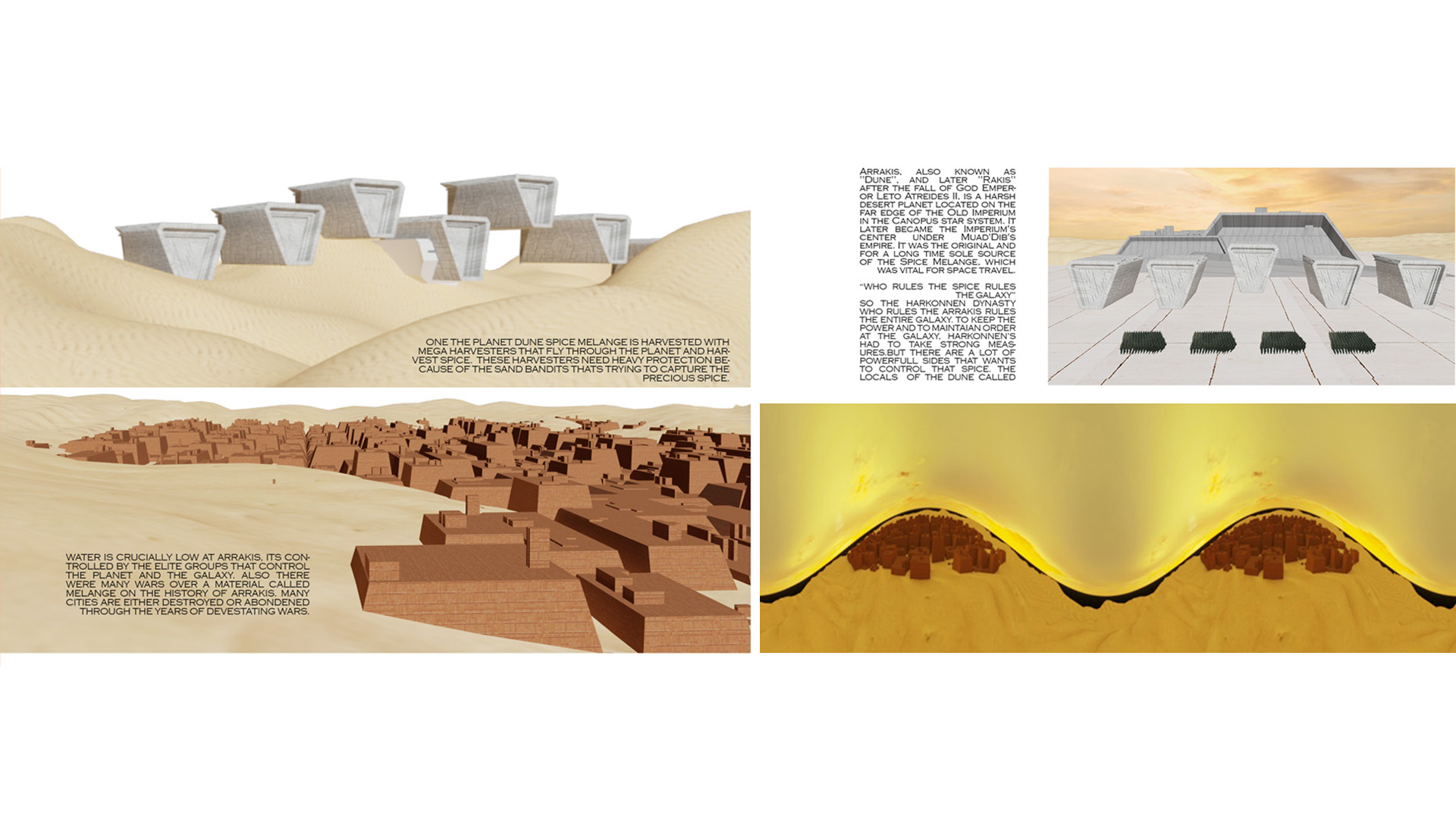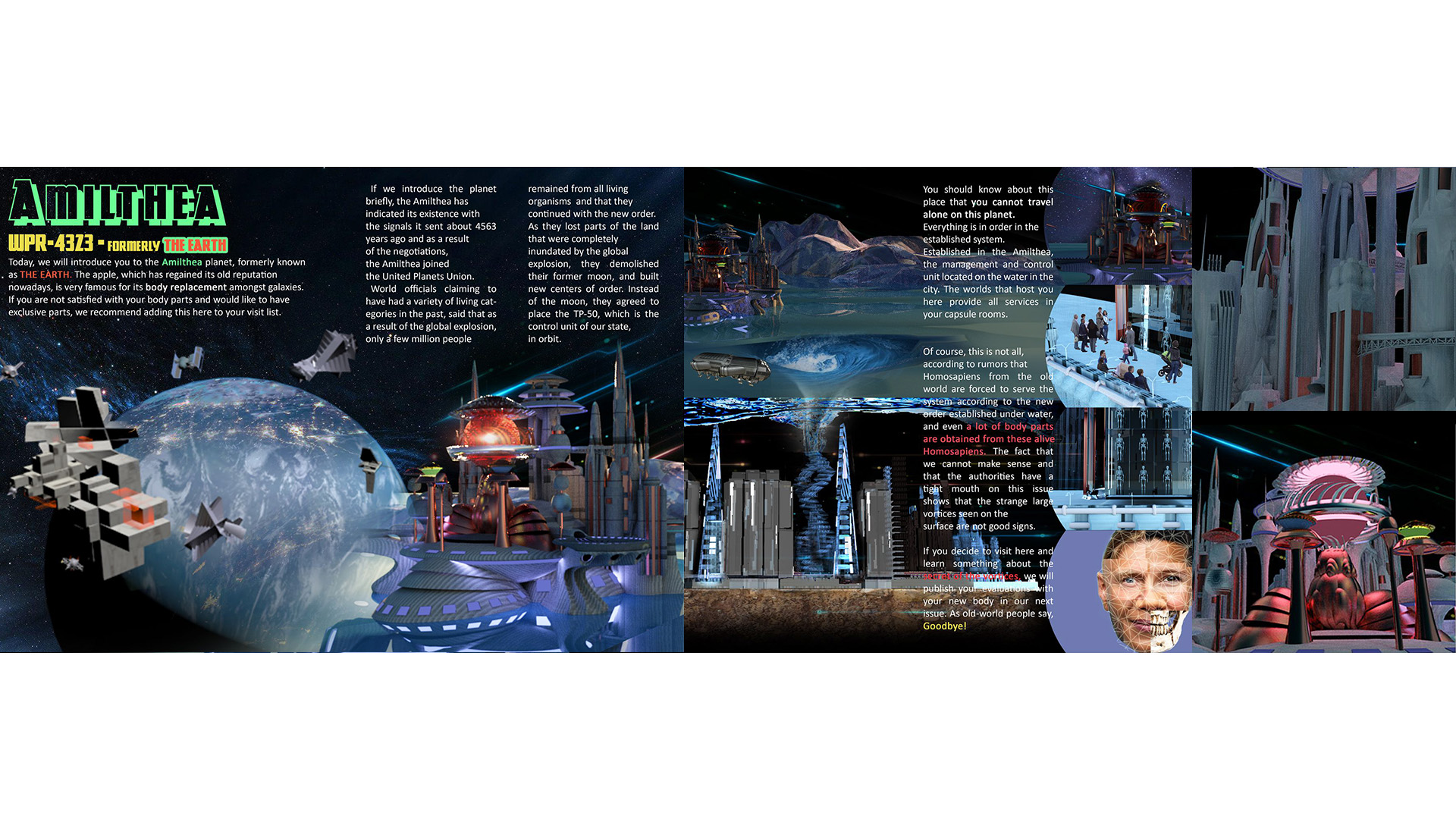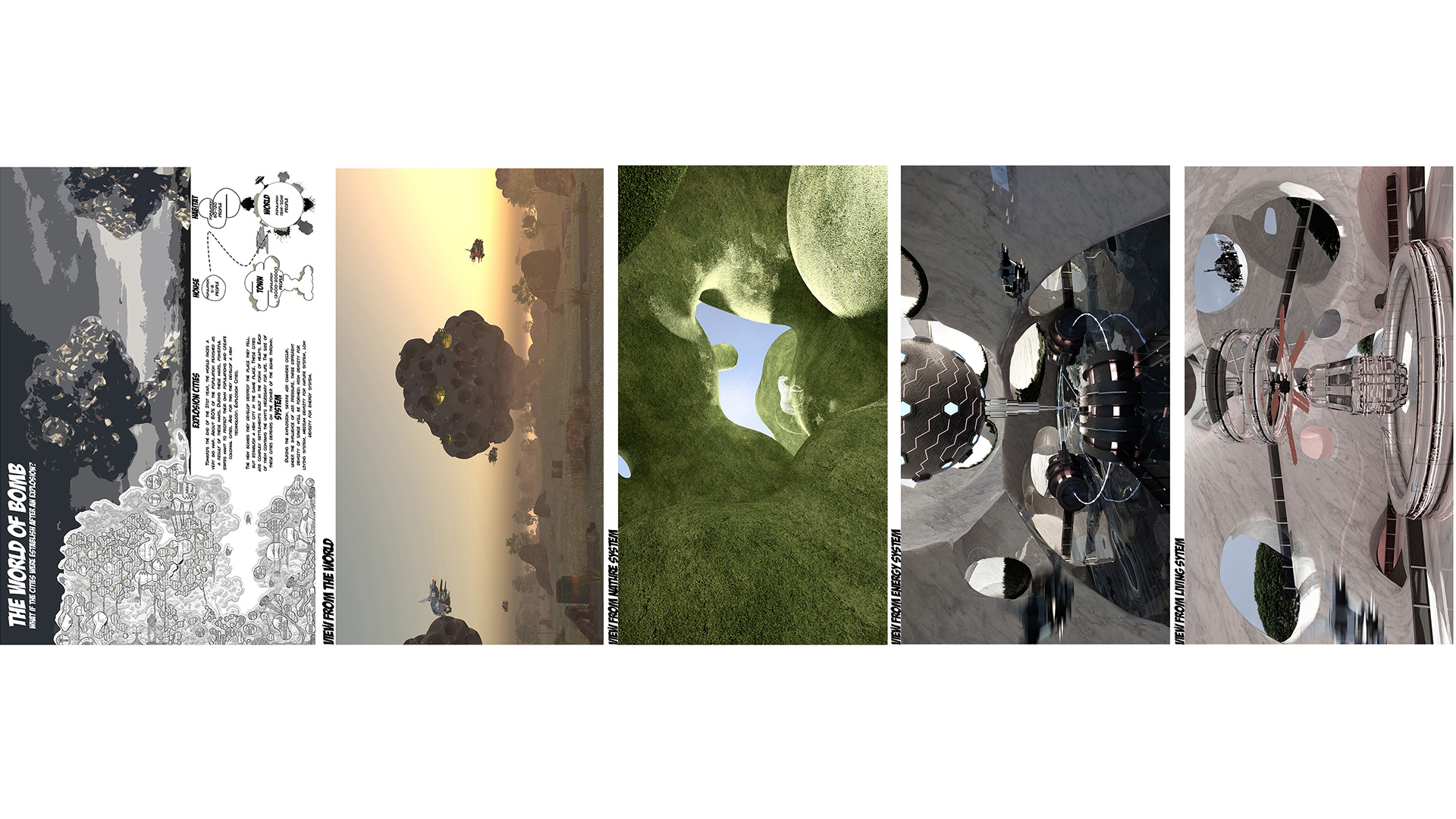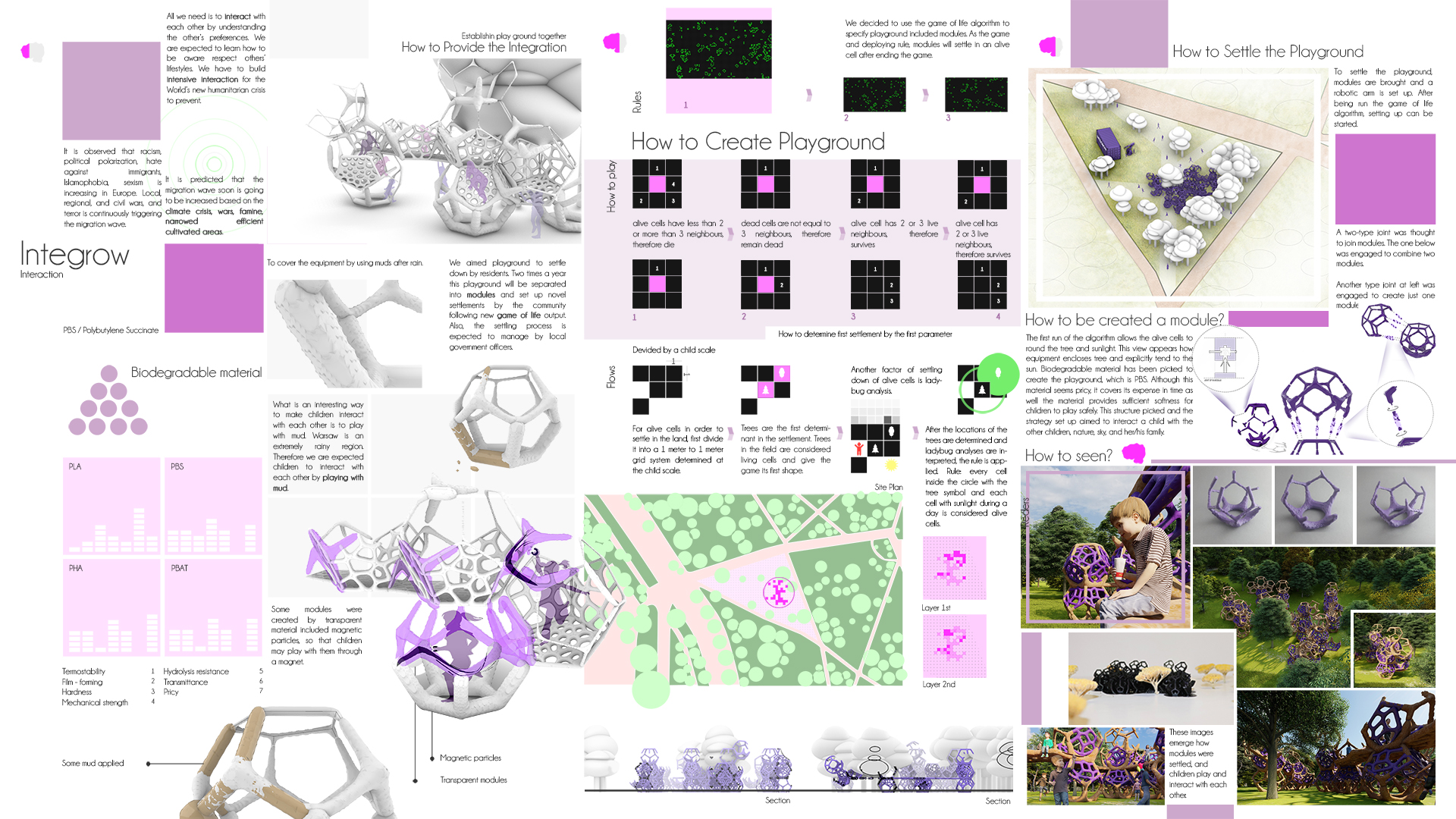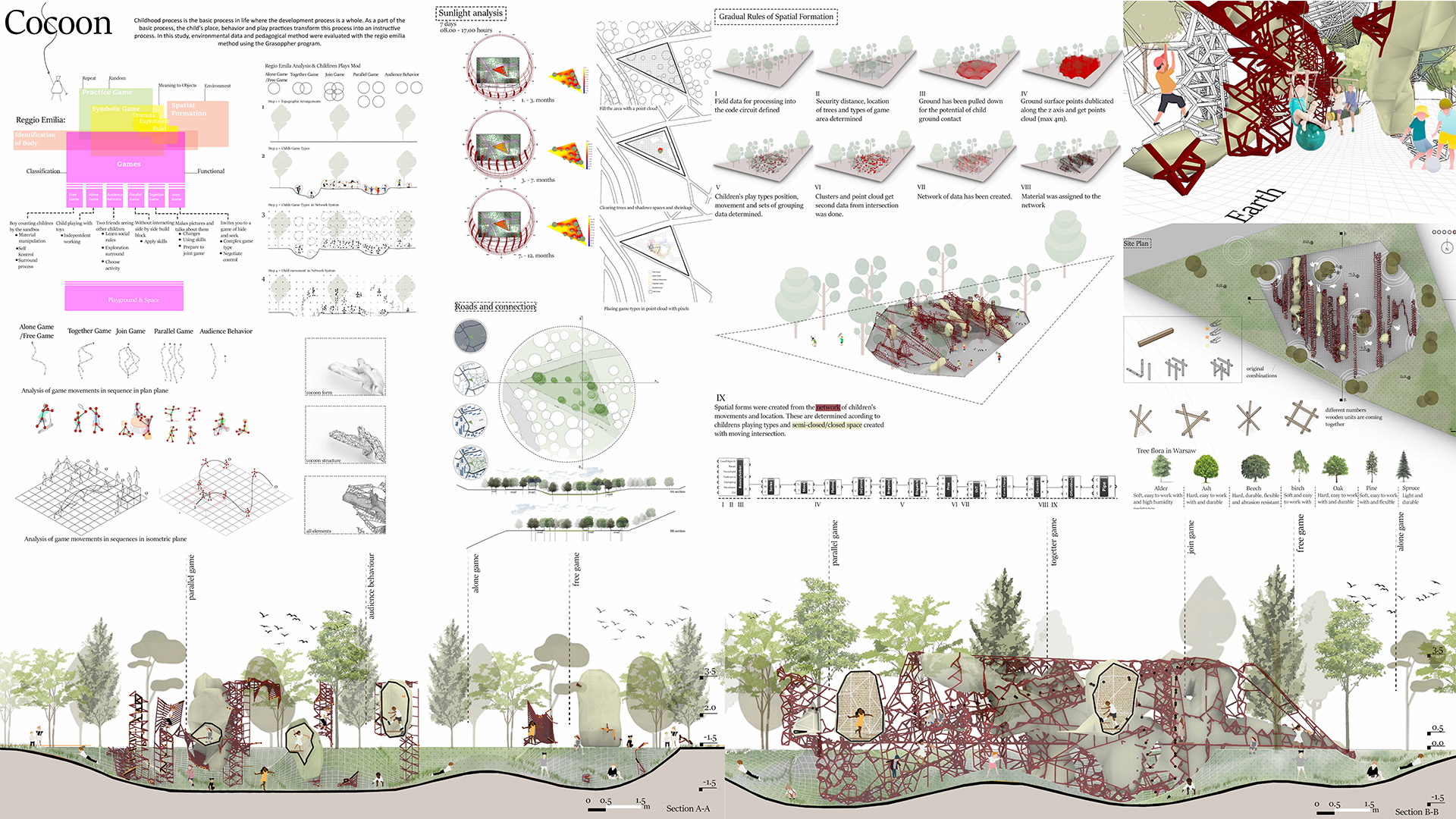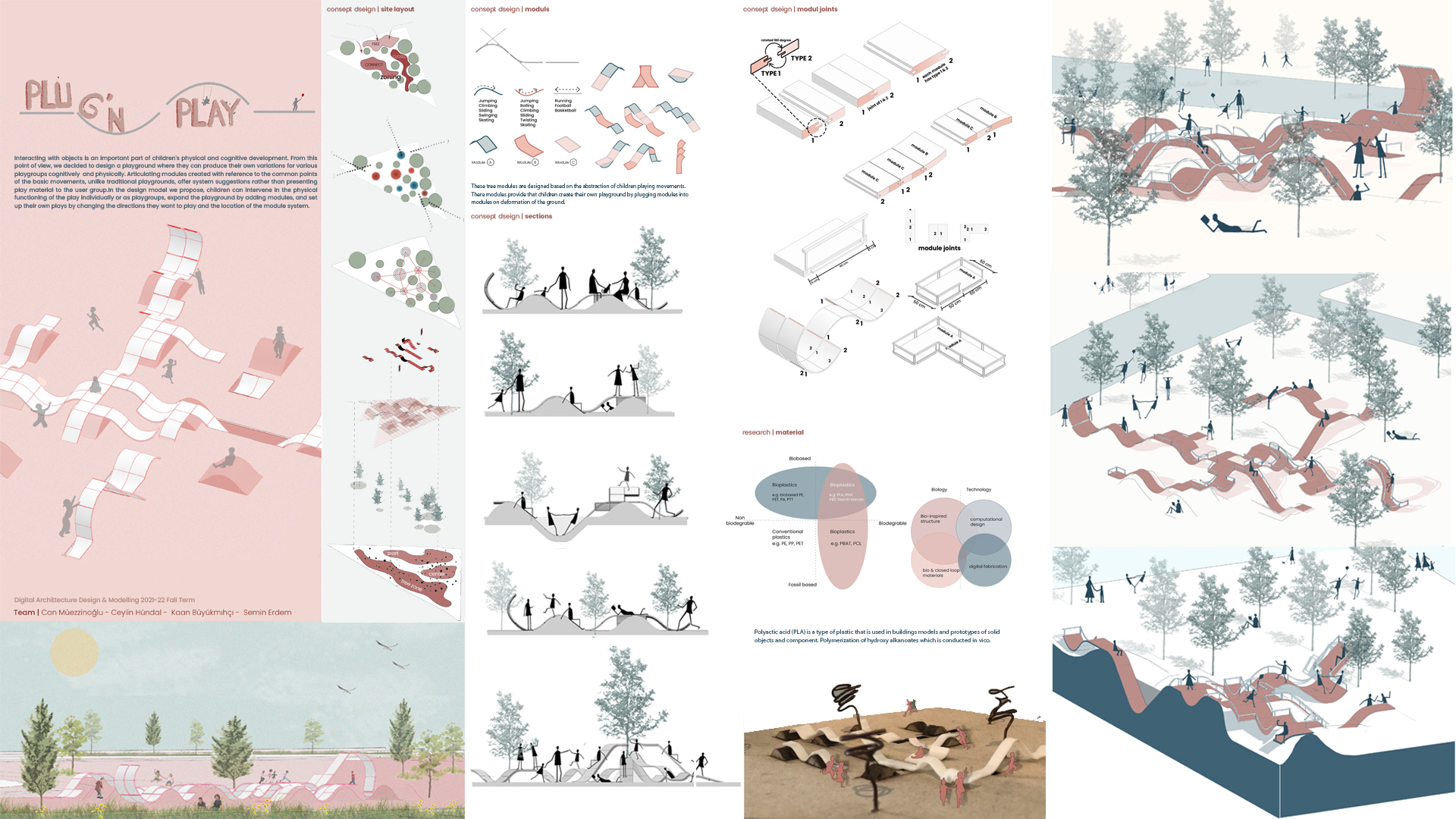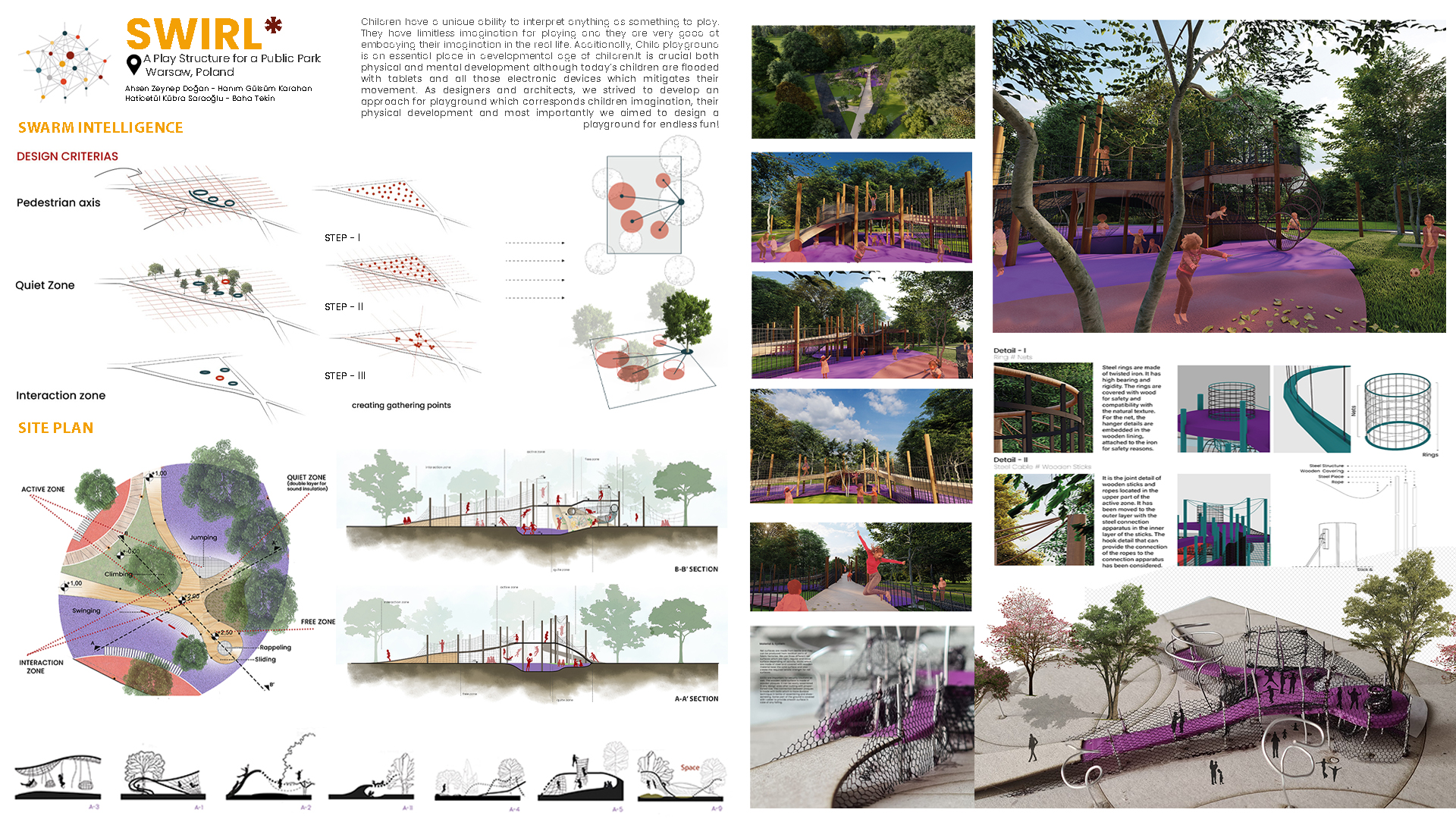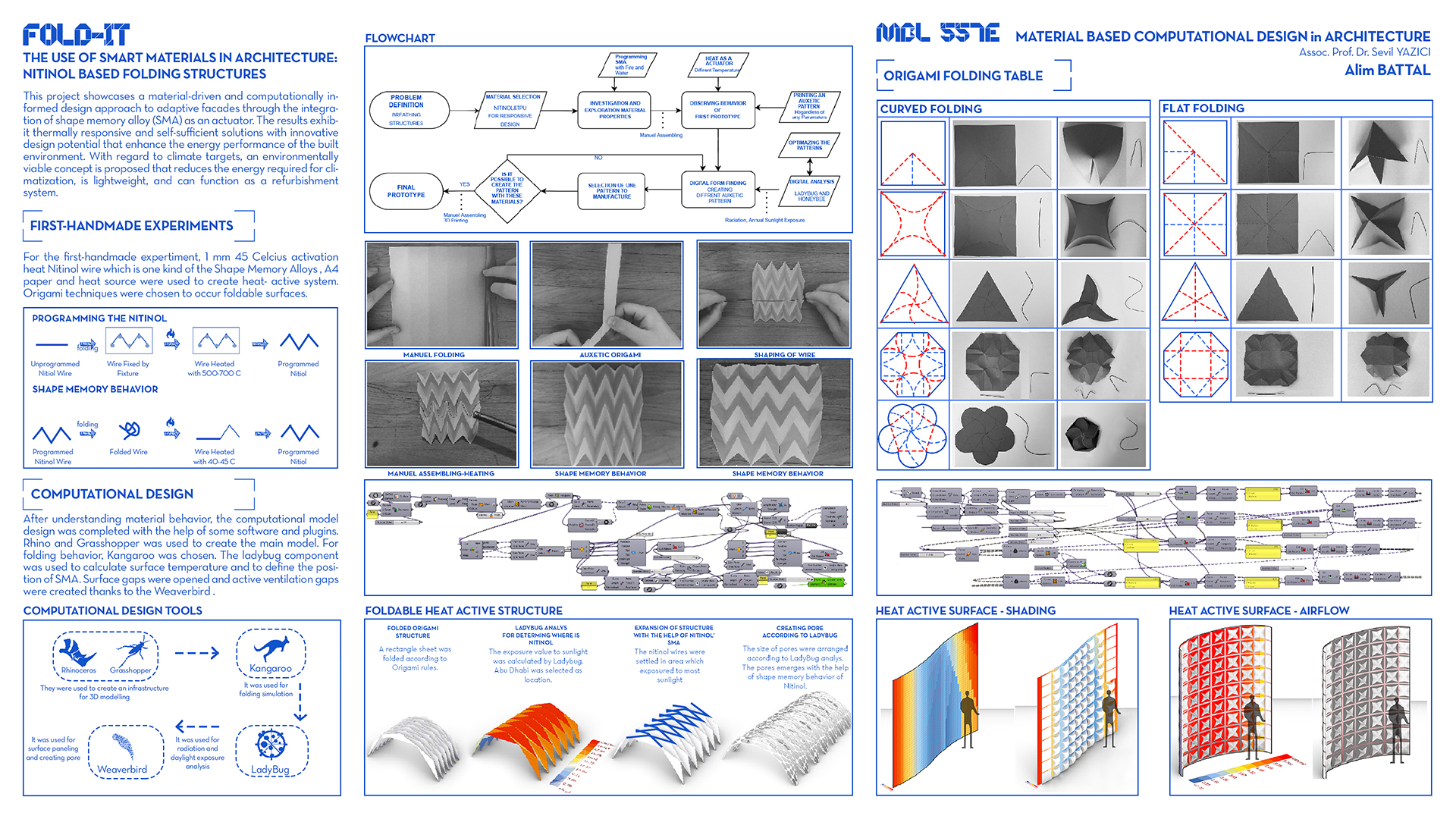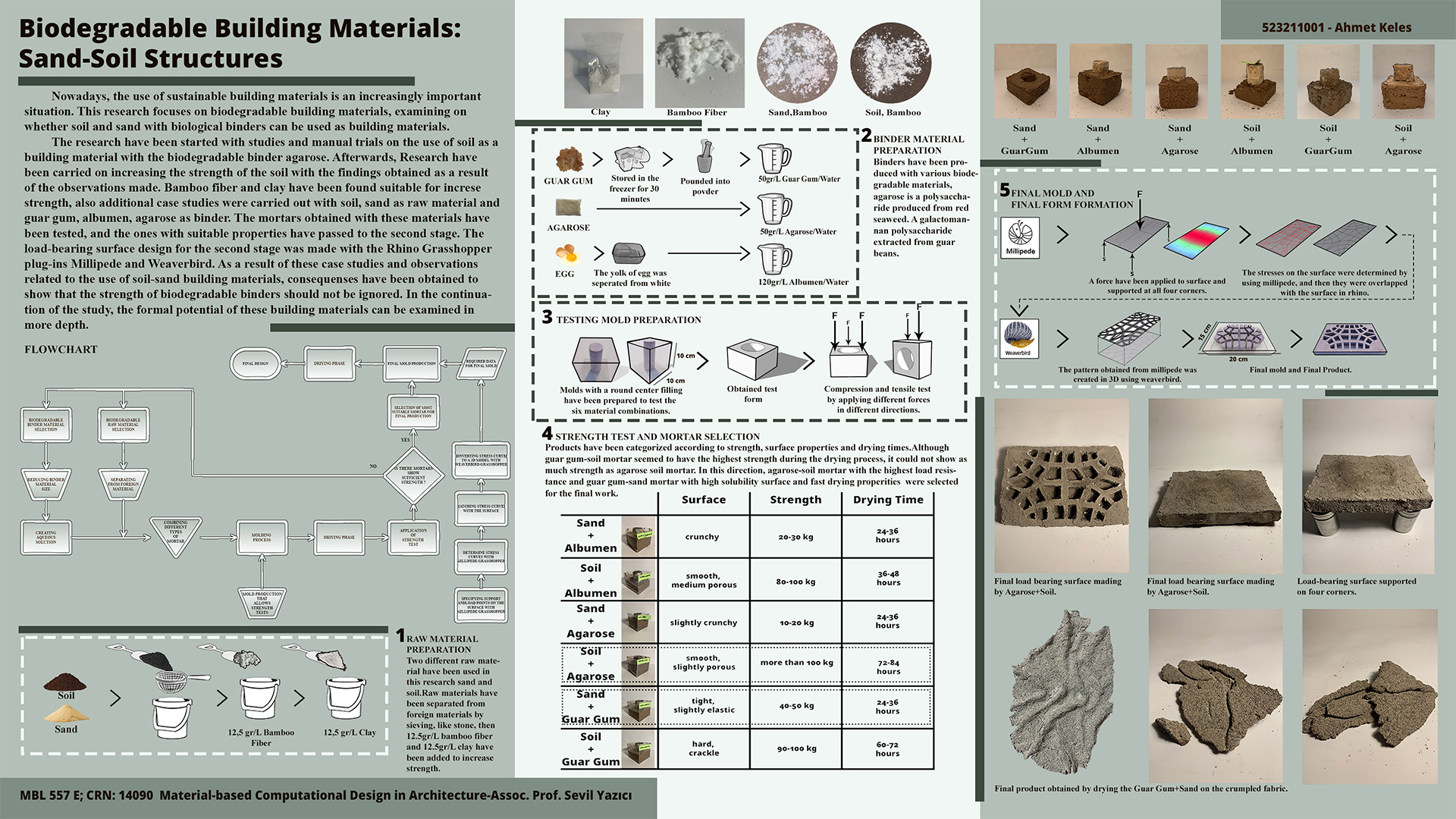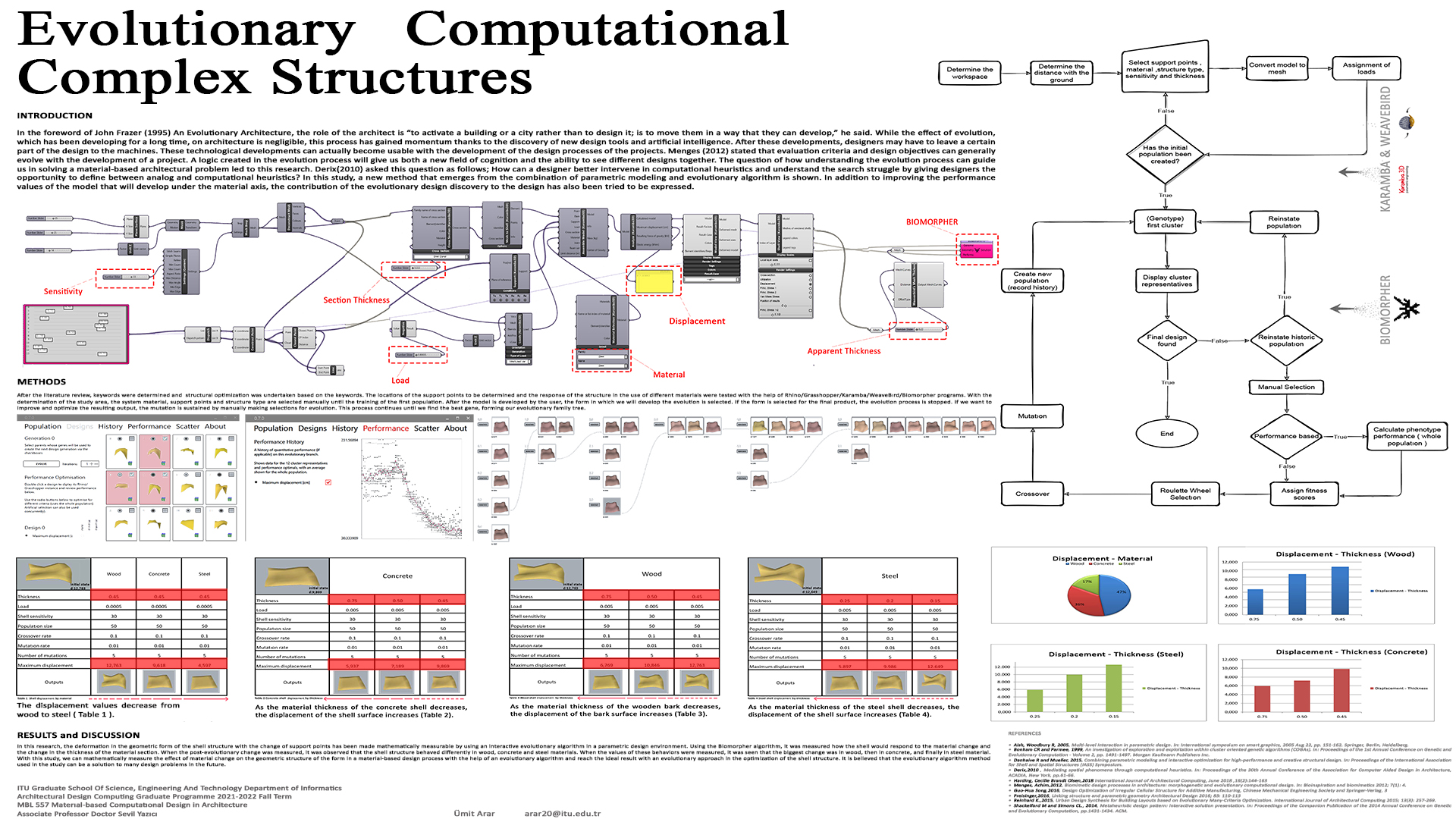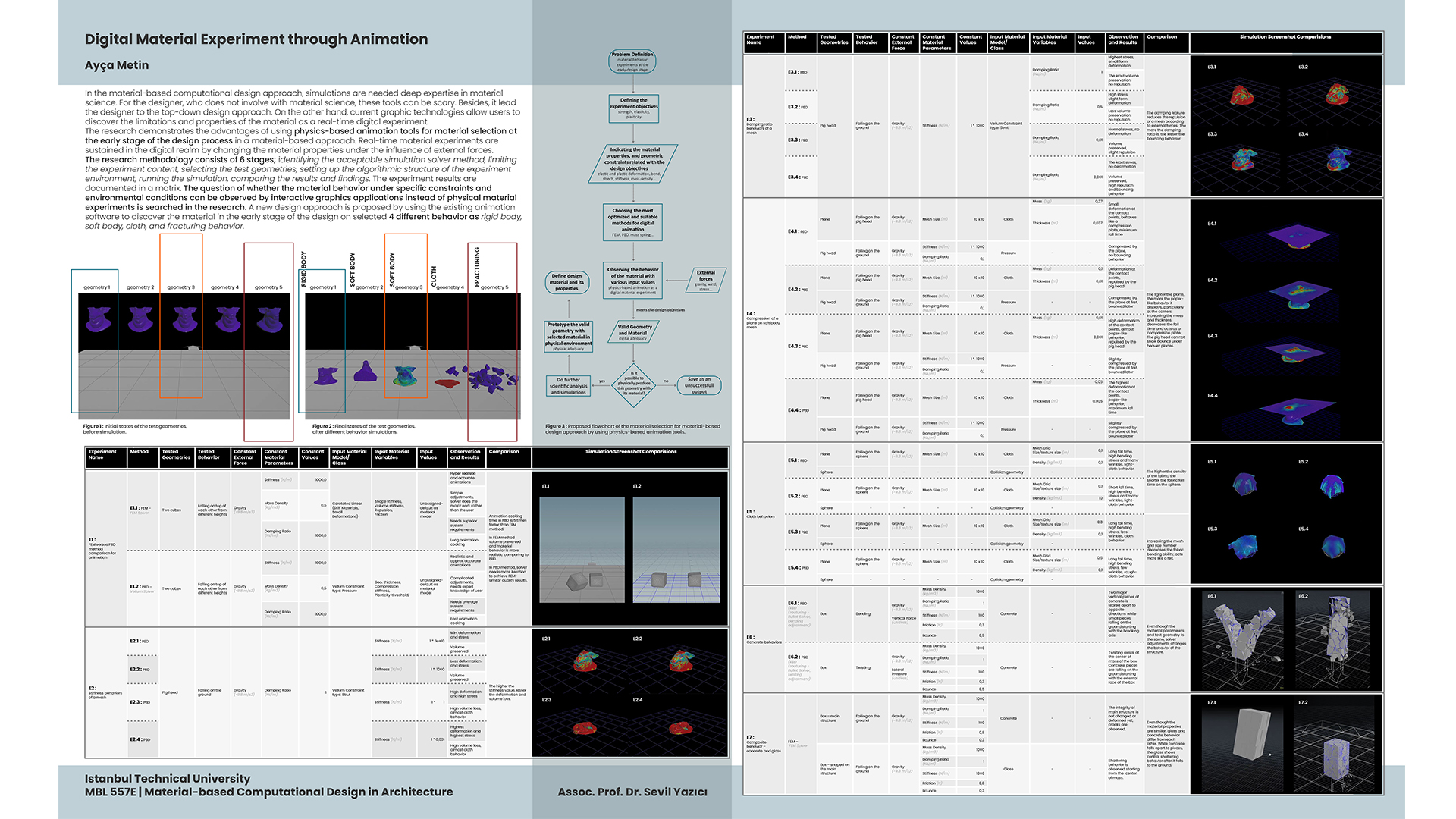

This is a selection of student work from the 2021-2022 fall term in the Architectural Design Computing Graduate Program.
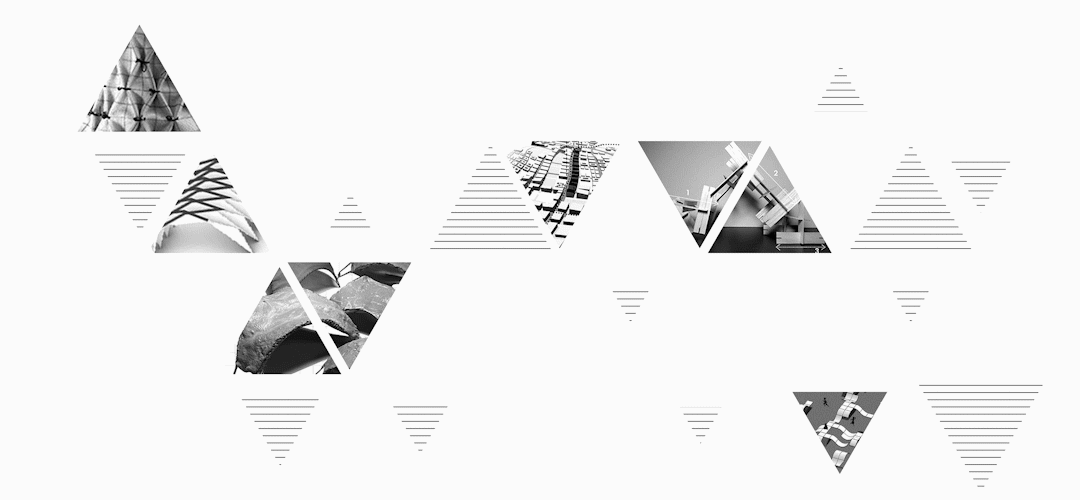
This is a selection of student work from the 2021-2022 fall term in the Architectural Design Computing Graduate Program.

From Mondrian to Klee – 3D Carpet Design
Measuring Safety Feeling for Walkability
Urban Network Generation using Reaction-Diffusion: Gray-Scott Model
Livin* City
3dTetris: A Design Study for Exploring Block-based 3d Modeling & Procedural Generation Using Game Style User Interaction
The Possibilities of City: Meiorama
Object Detection for Ancient Greek Columns
phoTOpography
MBL533E Computer-Aided Architectural Design
Instructor: Dr. Hakan Tong
GAMEUI/2021
“SPACEWAR”, developed by Steve Russell in 1962 and accepted as the first computer game that defines space as a two-dimensional user interface. Today, the development of environments in games has led to the need for more comprehensive and more realistic space designs in interfaces. In this context, the students are expected to use a movie, a story, a picture, a comic book or their own dreams as basis to create a game interface with the information obtained within this course. At the end of the semester, a poster containing written information and visuals of the studied interface will be prepared. In addition, two panoramic images will be delivered for VR from two points that you think best describe the interface.
Post Flooded City
Walking City
See For Space
Mahmoud Badnjki
Ceylin Ceyda Hündal
Mehmet Salih Özalp
C(ry)loud of Fractus
Expanse Ring Volume
Walking City
Seyma Bengü Özmutlu
Münir Kelesoglu
Handenur Okur
Star Trek Romulan Capital
The World of Saliva- The New Born
Agriculture Meteorite
Ahmet Keles
Baha Tekin
Homa Raeissi
Taan
Stargate Atlantis
The Sun of the New Life
Asude Sena Kösebas
Nilüfer Gizem Yazkan
Nursena Coskun Müstekin
Donnie Darko
New Born Earth
Fight Cage in Oasis
Özgün Simsek
Ideen Irandoost
Baver Bekiroglu
Snowpiercer
Reach The Top
Five Dimensional Space
Basak Boztas
Ahsen Zeynep Dogan
Abdalrahman Alashi
Dune
Amilthea
The World of Bomb
Kaan Büyükmıhcı
Betül Sen
Alim Battal
Octavia
Zeynep Erkoç
Students were expected to investigate digital architectural design solutions and methods within this studio. They were expected to work in groups, to enter an international competition of a playground. As it is stated in the competition description: “To generate a healthy lifestyle, the activity schedule must satisfy physical, mental, and social needs for well-being. The experiences of digital play are enticing due to its newness and novelty, so it is important that physical play is also made to be as engaging and attractive for kids.” (https://uni.xyz/competitions/child-play/info/about)
How can outdoor play be transformed to make it inviting to children? How can it be materialized with computer-aided design tools and methodologies?
MBL 557E Material Based Computational Design in Architecture
Instructor: Assoc. Prof. Dr. Sevil Yazıcı
This course introduces the role of materials in the architectural design process; assessment of the material, form, and performance in natural systems integrally; computational design process run by materials in architecture; properties of materials affecting architectural design; the relationship between structure, performance, optimization, and digital fabrication methods; design between scales; reinterpreting material systems in architecture by digital design and fabrication methods; material synthesis in architectural design by evaluating different types of parameters. As a term project, participants identified a research problem and developed a solution towards that by the use of material-based computational design methods in the 2021- 2022 Fall Term.
Reappraising Shape Grammars within Material Behaviour
The Use of Smart Materials in Architecture: Nitinol Based Folding Structures
Biodegradable Building Materials: Sand-Soil Structures
Evolutionary Computational Complex Structures
Fabric Manipulation, Concrete Fabric Material Testing
Digital Material Experiment through Animation
MBL611 Phenomenology and Hermeneutics in Computational Design
Instructor: Assist. Prof. Dr. Ethem Gürer
Genel anlamda günümüzde sayısal düsünce, nadiren rasyonel, analitik ve pragmatik geleneklerin dısında tartısılmaktadır. Bu dersin öncelikli amacı, sayısal düsünmenin analitik ve rasyonel temellerinden farklı ve fakat bu temelleri tamamlayıcı bütüncül bir düsünme biçimini tanıtmaktır. Felsefedeki fenomenolojik ve hermenötik (yorumbilim) yaklasımlar, bu düsün biçiminin olusturulmasında yöntem, izlek ve ufuk olusturmaktadır.
Dersin final ödevi, “Ölçülemeyeni Ölçmek” teması altında, tasarım ve sayısal düsünme arakesitinde ögrencilerin nicel anlamda ölçümü olanaklı olmayan tasarım meselelerine nitel ölçüm ve degerlendirme yaklasım ve yöntemlerini kullanarak özgün ölçütler gelistirmeyi hedefleyen, akademik nitelikte yayına hazır bir makale üretmektir.
Numerical thinking today is rarely discussed outside the rational, analytical, and pragmatic traditions. The primary aim of this course is to introduce a holistic way of thinking that is different from, but complementary to, the analytical and rational foundations of numerical thinking. Phenomenological and hermeneutic approaches in philosophy create a method, path, and horizon in the formation of this way of thinking.
The final assignment of the course, under the theme of “Measuring the Unmeasurable”, is to produce a ready-to-publish academic article that aims to develop original criteria by using qualitative measurement and evaluation approaches and methods for design issues that cannot be measured quantitatively by students in the intersection of design and numerical thinking.
Measurement of Sensitivity Based on Different Production Techniques in the Digital Fabrication Process
With digital fabrication, which has become widespread today, the concepts of suitability, applicability, adaptability, and sensitivity in production have started to gain importance. The relationship between the model prepared in the digital environment and the model produced in the physical environment depends on the sensitivity ratio in digital fabrication. Accordingly, the aim of the study is to measure the sensitivity rate that will change depending on different production techniques in the fabrication of Möbius Strip, which is a non-standard double curvature surface form created in digital environment with computational design tools and can be developed. The non-standard double curvature surface discussed within the scope of the study will be created depending on the additive (three-dimensional printing), subtractive (hot wire cut reduction, CNC), folding production techniques. The sensitivity ratio of the obtained surface to the optimum level will be discussed with the comparative analysis method. In addition, it will be tried to determine the factors affecting the production of physical models to be created in the real environment, unlike simulation models. The precision measurements of the double curvature surface, whose physical models were created depending on different production techniques, were handled with three-dimensional scanning technology. A comparative analysis model was used with the digital model, depending on the three-dimensional scans considered. Among the three-dimensional scanning technologies, three-dimensional scanning with the Kinect tool and physical models were transferred to the digital environment with the Photogrammetry technique to provide competent results depending on the scale. The use of computational design tools, which are aimed to be developed within the scope of the study, and the computational design tools, which have become widespread recently but still cannot find their place in the disciplines, will be a resource for students, instructors and researchers who will work on the research of experimental shape finding tools. In addition, studies on the transferability of the materials discussed in this study to digital media and the determination of material behavior will contribute to the literature on this subject.
Keywords: Digital fabrication, Sensitivity, Computational design tools, Non-standard Double curvature surface, Möbius strip
Perception of the Solid & Void Relationships of the Facades According to the Design Style
Architects frequently employ Gestalt ideas as a design strategy in the design field. Gestalt is a German term that translates as ‘shape’ or ‘form. Gestalt principles alter our perception of design products by emphasizing notions such as completing the whole from its pieces, shape and ground, solid and void. Within the purpose of the study, exterior views of four buildings with varying façade characteristics were shown to a group of nine first-year students at Istanbul Technical University’s Faculty of Architecture. These structures, which include rational surface-rational space, rational surface-amorphous space, amorphous surface-amorphous space, and amorphous surface-rational space, were chosen from a pool of structures with comparable scales. The purpose of this study is to evaluate how students at the same educational level perceive buildings constructed using a variety of design languages and expressive strategies. Each image will be examined for three minutes by the students that comprise the topic group. Following the evaluation process, students were instructed to draw the picture for five minutes. After completing the drawing step, students responded to the pertinent survey questions.
Keywords: Perception in design, Gestalt principles, Mental imagery.
Rethinking The Transformation of the Perception of the Housing Image in the Human Mind Through Pandemic Conditions
Housing is one of the most important elements that meet one of the most basic needs of the individual, which is shelter, and enable the individual to live in a safe and comfortable way. Housing not only meets the need for shelter, but also meets certain psychological and social needs. Housing use reflects the personality of the individual, his lifestyle, and the individual’s own essence. For this reason, the perception of the house image in each individual is different. In this context, perception is a product that emerges as a result of the data obtained by sensing from the environment gaining a meaning in the mind of the individual, and perception includes a cognitive process. This process can change with the developments in the life of the individual. Factors such as changing conditions throughout life, differences in the individual’s knowledge and current mood can change the perception. In connection with this, the quarantine measures implemented due to Covid-19, which affected the whole world, transformed and changed the perception of the housing image in the human mind. In this study, it is aimed to reveal the equivalent of these concepts in the human mind by examining the changing housing image and perception through the pandemic conditions with a phenomenological perspective. In order to do this, first of all, a literature review was conducted, and then inferences were made about the spatial setups and boundaries of the house before and during the pandemic. It is aimed to measure the transformation of the perception of housing in the human mind before and during the pandemic. For this, a measurement method based on a visual representation is proposed. In the study, 10 participants were asked to draw cognition maps. As a result of this, inferences were obtained according to the visual representations. The data collected from the participants were evaluated by focusing on the perceptual changes of the housing image from an architectural point of view.
Keywords: House, Pandemic, Space, Perception, Phenomenology
Kentsel Ölçekte Zaman-Mesafenin Gösterim Çesitleri ve Anamorfoz Gösterim Önerisi
Mesafe algısı, geleneksel olarak statik çizimler üzerinden biçimlenir. Kentsel ölçekte ekosistemde etkilesime giren bilesen miktarı çogaldıkça ve iliski türleri karmasıklastıkça, zaman parametresi daha çok önem kazanır. Sabit zaman aralıgındaki üretilmis, haritanın formunun sabit tutuldugu görsellestirme önerileri olan izokron haritalar zaman parametresinin etkilerinin gösterildigi ilk harita örneklerinden biridir. Bu haritaların süre gecisi kavramını sabit bir zaman aralıgında islemesi ve bu gösterimin zaman-mesafe anlatımını tam karsılamıyor olması bu haritaların farklılasmasına, farklı zaman birimlerinin de tek bir izokron harita üzerinde gösterilmesi dogrultusunda gelistirilmistir. Bu harita gösterimlerinin yanı sıra daha icgüdüsel bir gösterim olarak kabul edebilecegimiz anamorfoz kartografi ise zaman mesafe anlatımını, geçen sürenin sabitlenip, haritanın anamorfik bir dönüsüme ugraması ile göstermeyi amaçlamaktadır. Çalısma kapsamında vaka çalısma alanı olarak Istanbul gibi devasa ve karısık bir sehrin seçilmesi, ulasım süre-mesafelerin kolayca öngörülemez hale gelmesi ve bunun halihazırdaki statik harita gösterimlerinin yeterli olmamasıdır. Bu nedenle öneri çalısma kapsamında statik haritalar yerine, zaman-mesafe gösteren anamorfik haritalar üretilmistir.
Keywords: Izokrone harita, Anamorfoz harita, Zaman-mesafe, Harita algısı, Mesafe algısı.
Measuring Spatial Perception through Visual Representation and Verbal Expression
Visual thinking and perception are important in architectural design. Design process progressed with drawings increases the importance of visuality. However, architectural design shouldn’t be limited to vision. Spatial perception is shaped by visual representation and verbal expression. Seeing and language provide access to different information about space. The aim of this study is to examine the formation of spatial perception through visual and verbal representations. The study is based on the view that grounding spatial perception on sight is restrictive when it is influenced also by language. Study suggests that visual and verbal representations support each other, strengthening spatial perception. The answers to how verbal expression affects visuals, and vice versa, and how spatial perception is shaped in line with this interaction were sought with protocol analysis. The study will shed light on the production of spatial tools by revealing the relationship between visual representation and verbal expression.
Keywords: Spatial perception, Visual representation, Verbal expression.
A Case Study on the Potential of Simulations to Reflect the Reality: A Virtual Representation of the Pedestrian Flow of the Museum Gazhane by Using Anylogic
Today, the use of simulations is increasing with the opportunities offered by technology, and it provides convenience by showing the installation stages of complex systems in advance by making instant and future predictions. Agent-based simulation systems are used for systems modeling, traffic flow, pedestrian simulation. It is used in architecture to provide a virtual representation of the space and user relationship. In the Museum Gazhane, at the same time during the weekend, the profiles obtained as a result of the observations created using the timing and observation method were modeled in an agent-based simulation named Anylogic and the results obtained matched with the real data, as a result of the difficulties and advantages encountered while establishing the model, this type of factor-based simulation These are the outputs of research on the potential of practices to reflect reality.
Keywords: Timing and tracking, Agent-based modeling, Simulation, Visitor flow.
CAD Modeling Process Comparison: Changing the Translation Mediums & Feedbacks Through Algorithmic Thinking
Cemal Koray Bingöl
This study compares the different modes of 3D CAD modelling processes using phenomenological methods. There are four types of experiments conducted through protocol studies. The modelling sequences were compared by collecting video data, textual data and dialogues. The data is visualized and compared through these visuals, and the dialogues of the participants are discussed throughout the descriptions they provided to accomplish the aimed 3D models. The outcomes of the analyses showed no common sequential changes in the absence of haptic, visual or verbal feedback. However, the protocol studies showed that a potential intelligence is needed for the future of the CAD modelling software or intelligent design assistants. The outcomes are discussed thoroughly by speculating on the type of knowledge required to assist design processes.
Keywords: CAD, Design Thinking, Collaborative Design.
Contributors
Prof. Dr. Leman Figen Gül, Prof. Dr. Sinan Mert Sener, Assoc. Prof. Dr. Sema Alaçam, Assoc. Prof. Dr. Derya Güleç Özer, Assoc. Prof. Dr. Sevil Yazıcı, Assist. Prof. Dr. Ethem Gürer, Lec. Dr. Elif Sezen Yagmur Kilimci, Dr. Hakan Tong, Dr. Orkan Zeynel Güzelci, Abdalrahman Alashi, Ahmet Keles, Ahsen Zeynep Dogan, Asude Sena Kösebas, Alim Battal, Asude Sena Kösebas, Ayca Metin, Baha Tekin, Basak Boztas, Baver Bekiroglu, Bengü Özmutlu, Betül Sen, Can Müezzinoglu, Cemal Koray Bingöl, Ceylin Ceyda Hündal, Dogan Kalak, Elif Bahar Okuyucu, Fatih Uzun, Habibe Senkal, Handenur Okur, Hanım Gülsüm Karahan, Hatice Kübra Saraoglu, Homa Raeissi, Ideen Irandoost, Kaan Büyükmıhcı, Mahmoud Badnjki, Mehmet Salih Ozalp, Mert Cıgızoglu, Merve Tasdelen, Muhammet Munir Kelesoglu, Necmettin Sancak, Nilüfer Gizem Yazkan, Nur Sipahioglu, Nursena Coskun Müstekin, Osman Zinnur Melikoglu, Ozan Özvatan, Özgün Simsek, Rezzan Efil Erdogan, Semin Erdem, Seyma Bengü Özmutlu, Sinem Hallı, Umit Arar, Zeynep Erkoc.
Web Design: Res. Assist. Begum Hamzaoglu
Copyright © Architectural Design Computing Graduate Program of Istanbul Technical University, Graduate School, Department of Informatics, 2021. No part of this site, [mbi.itu.edu.tr], may be reproduced in whole or in part in any manner without the permission of the copyright owner.
